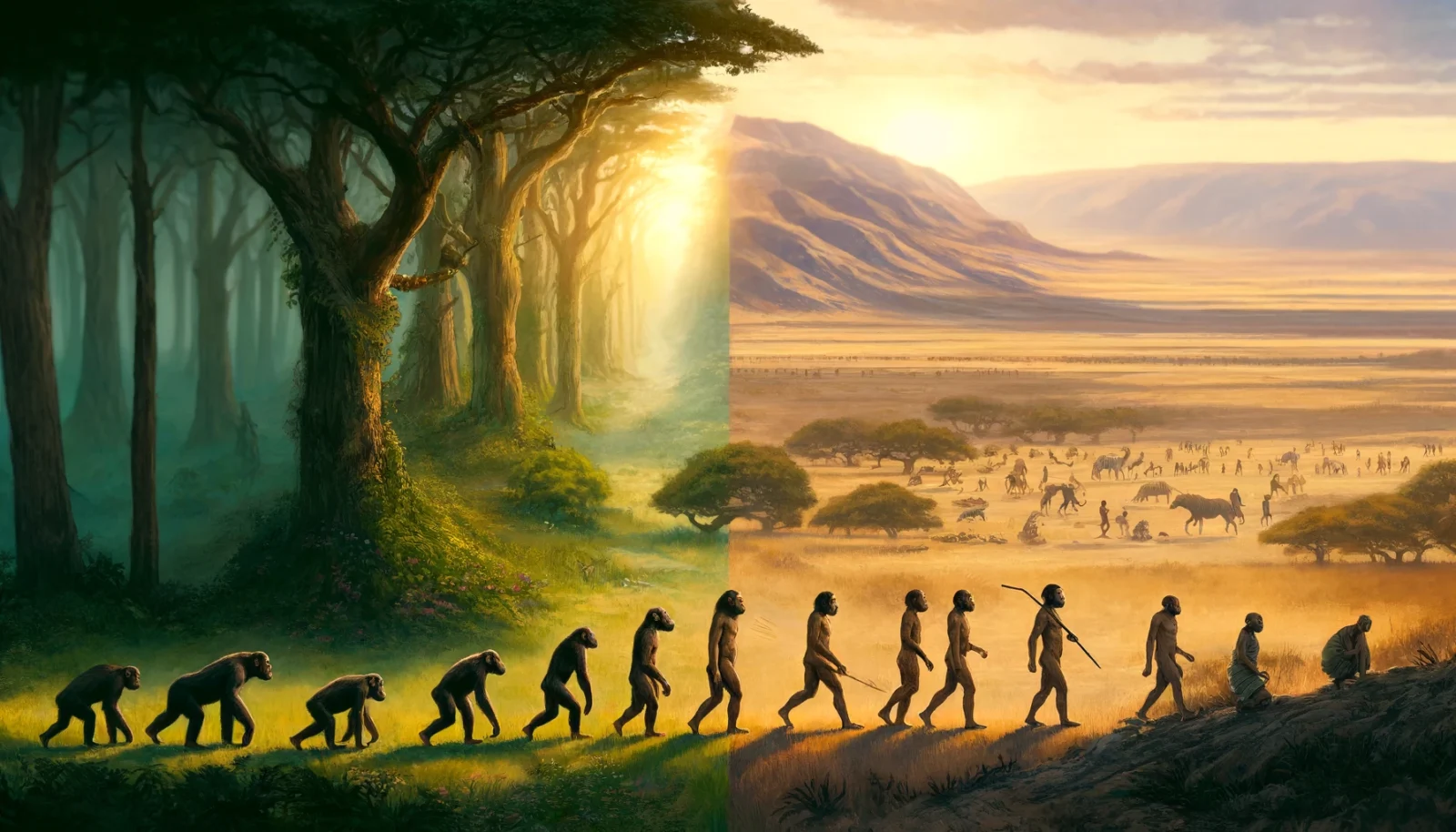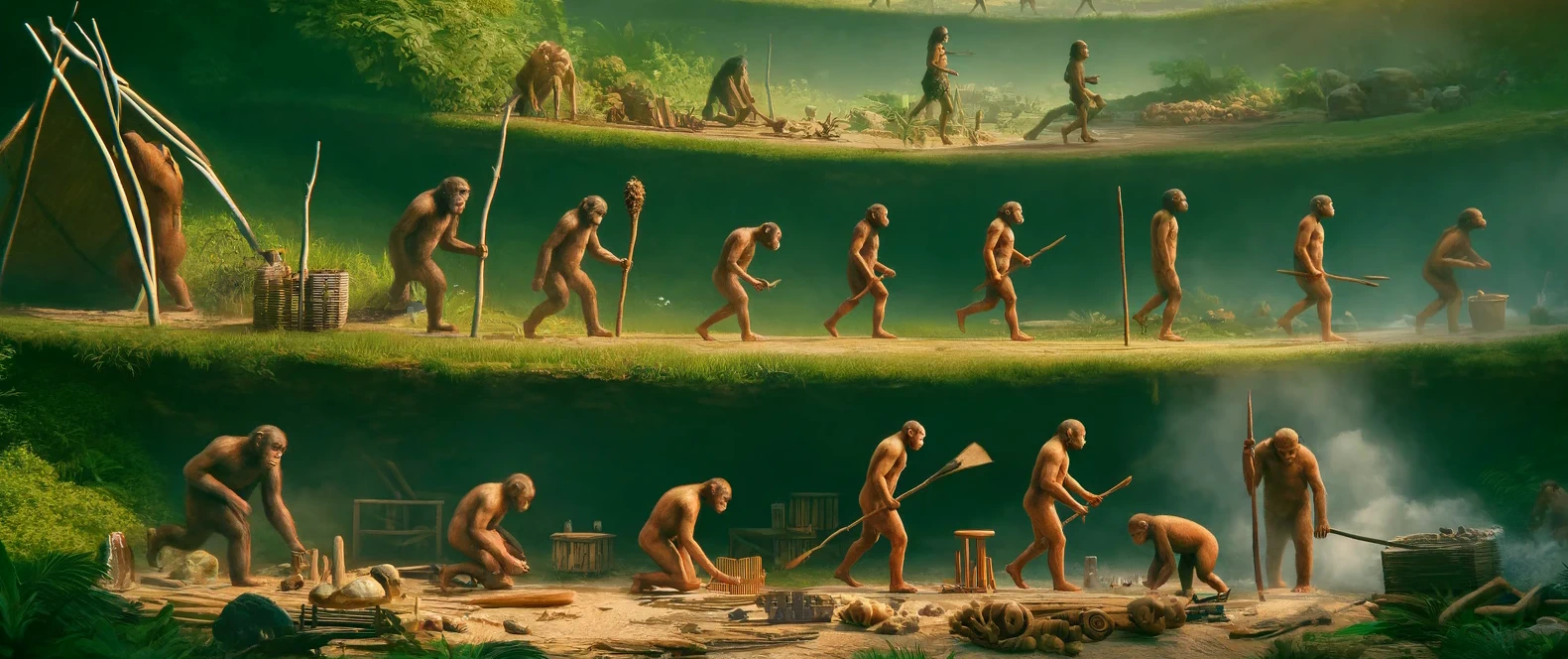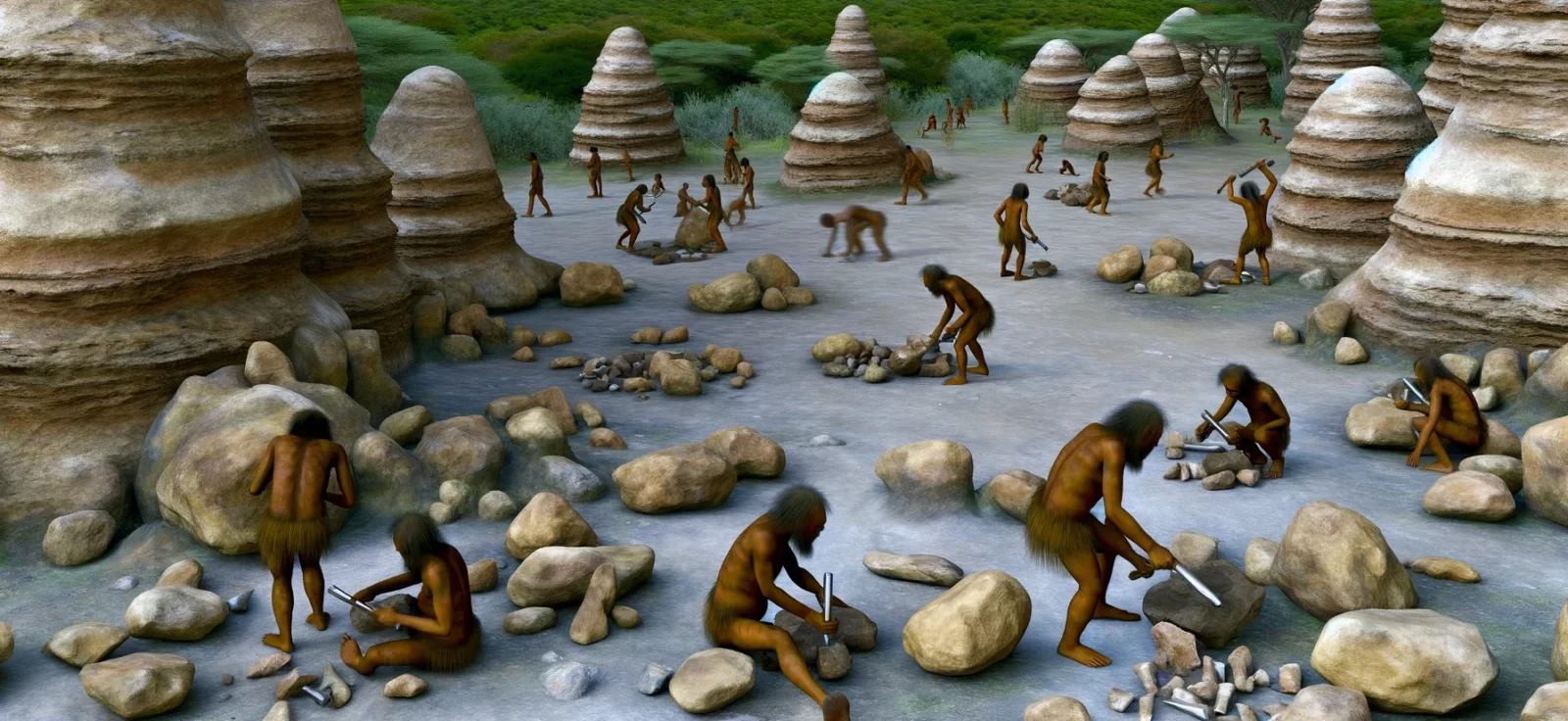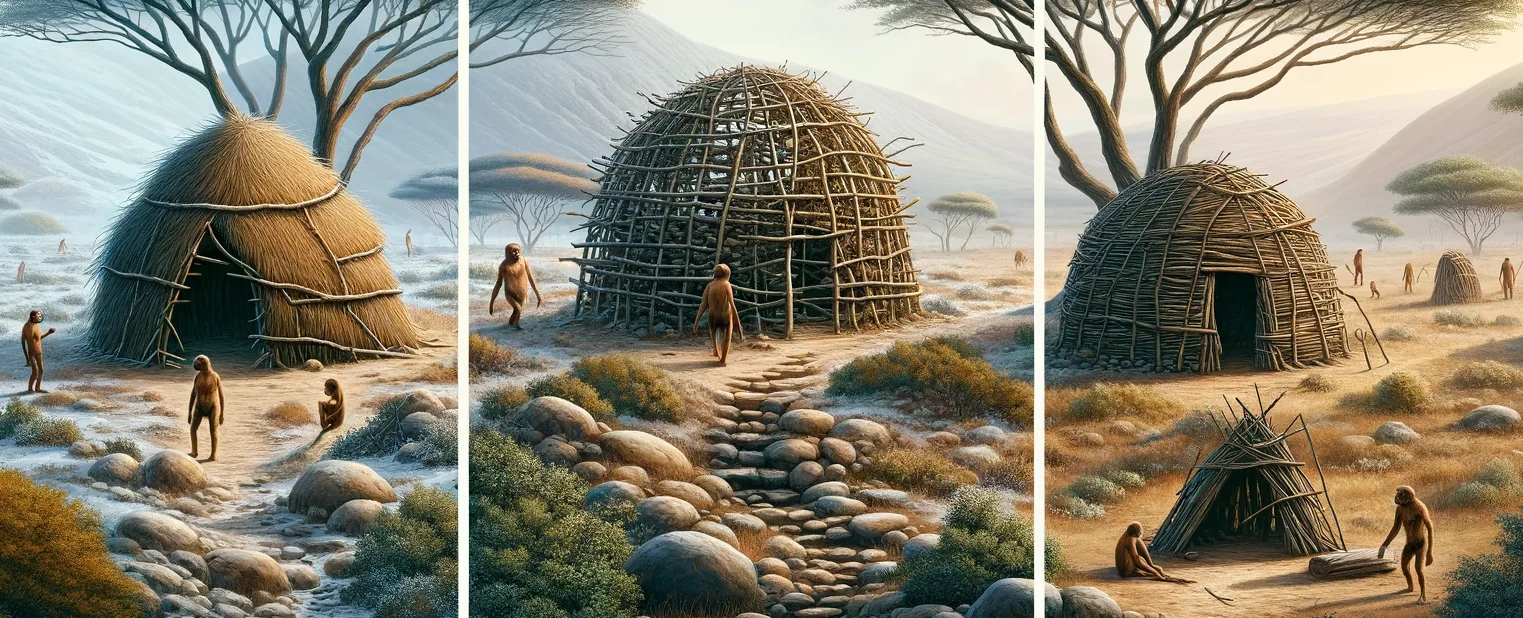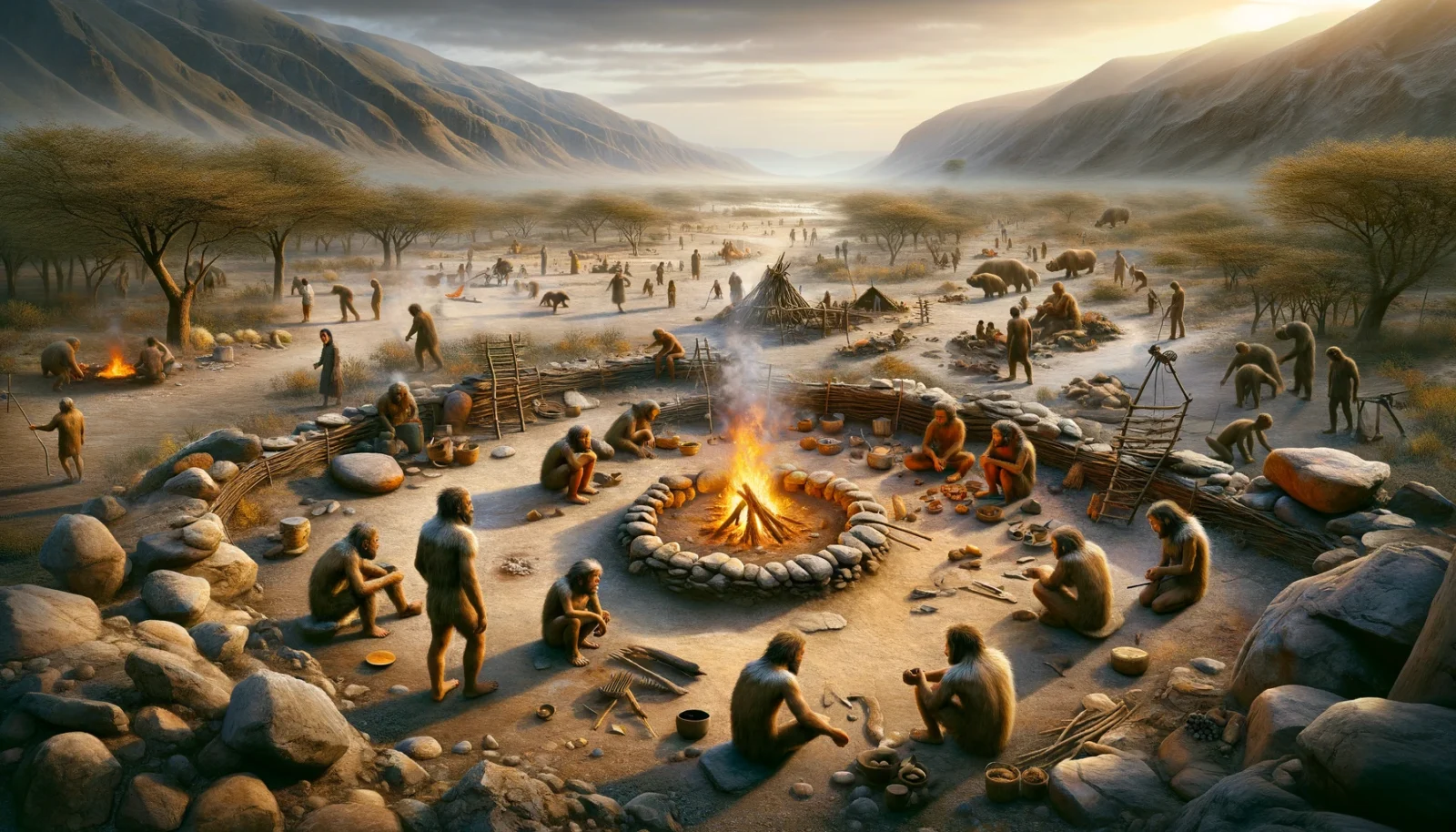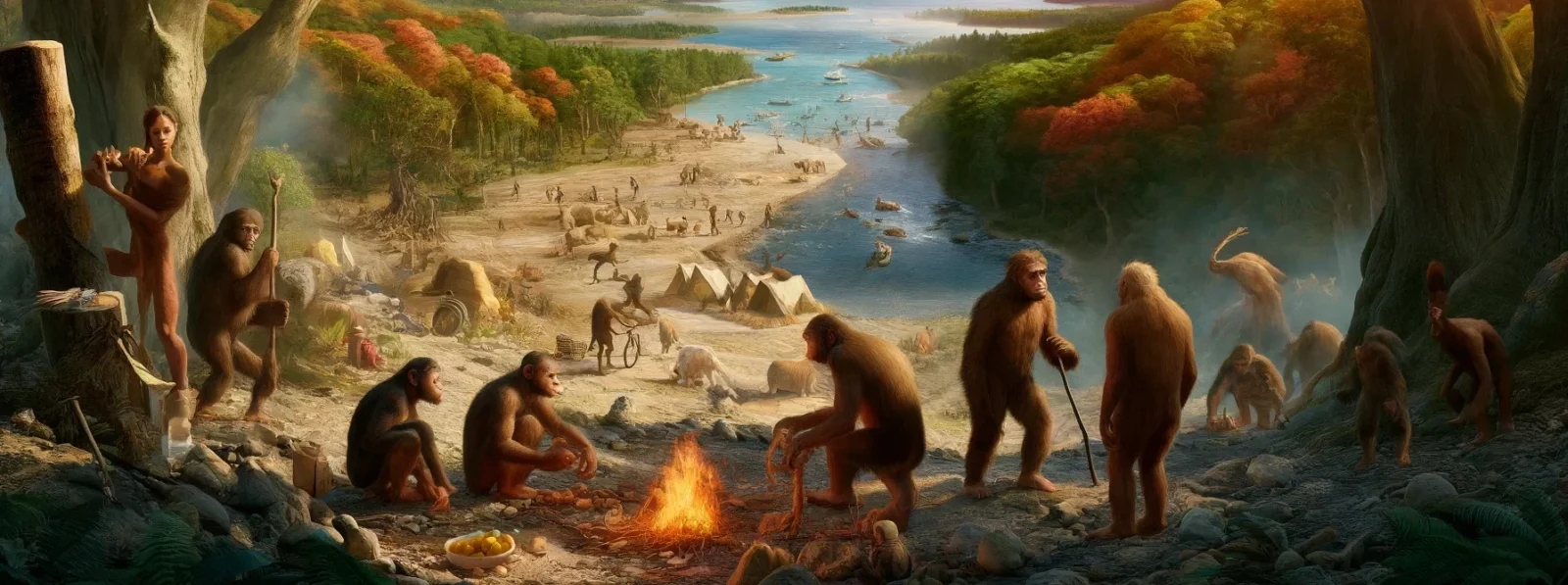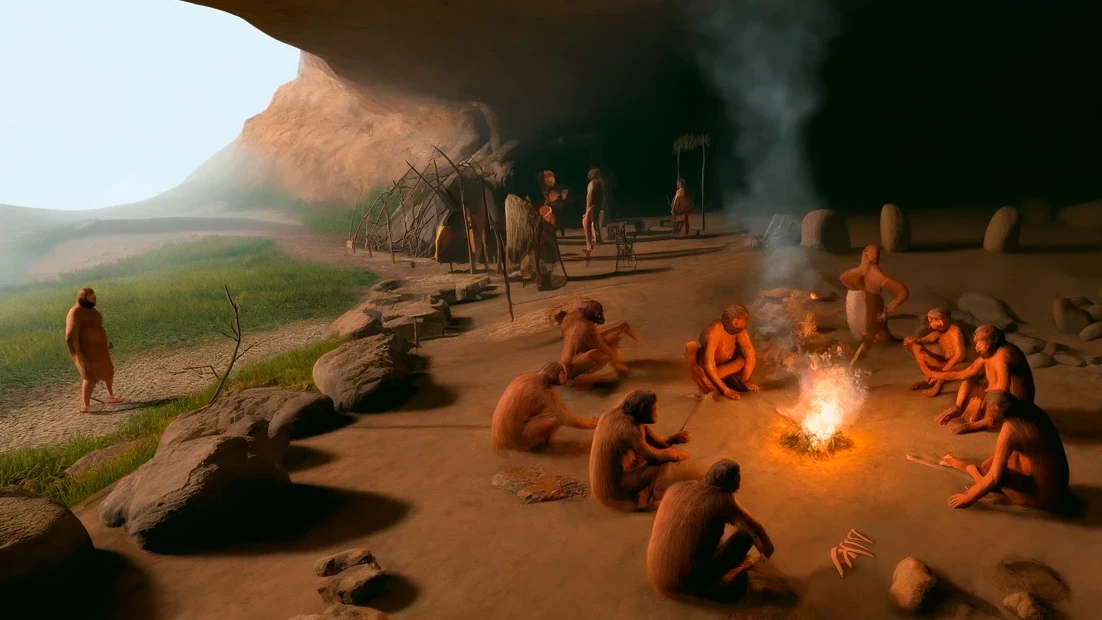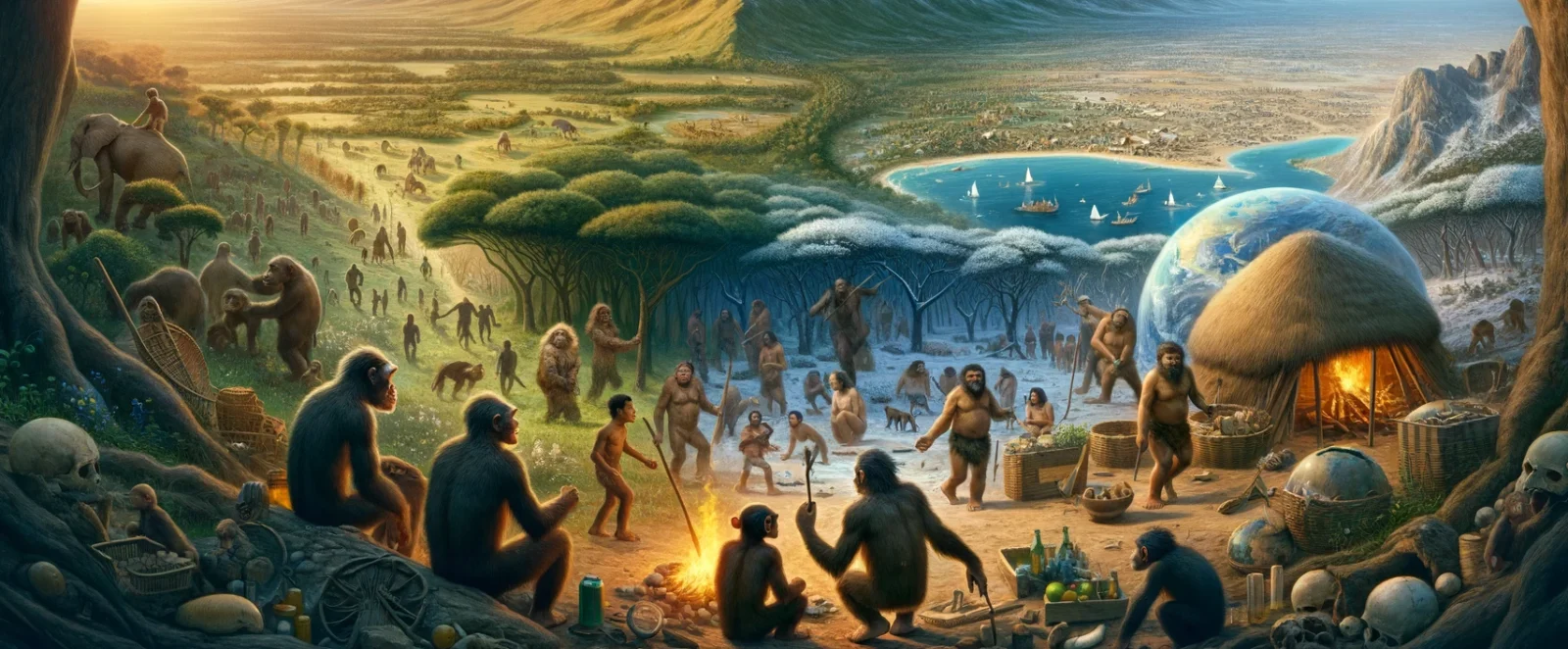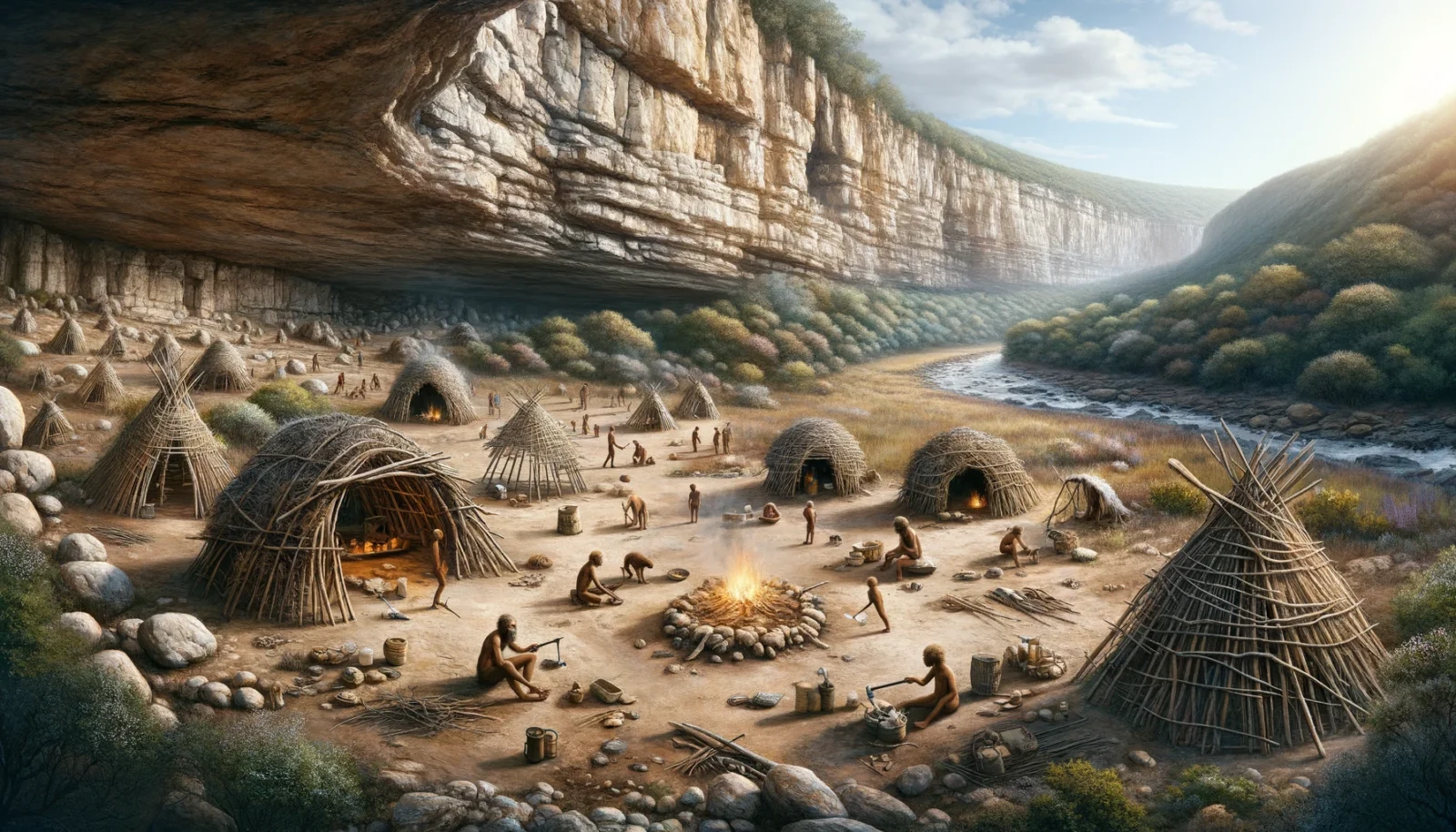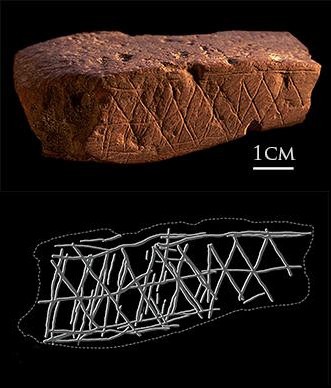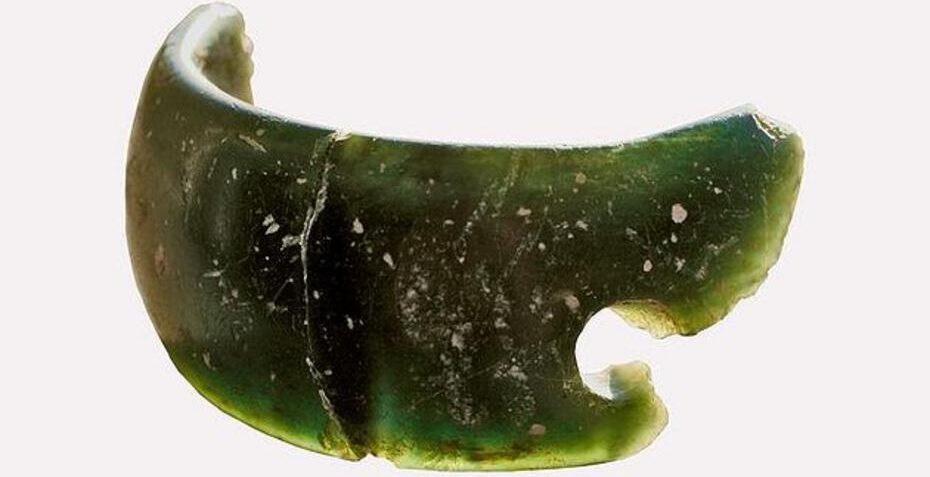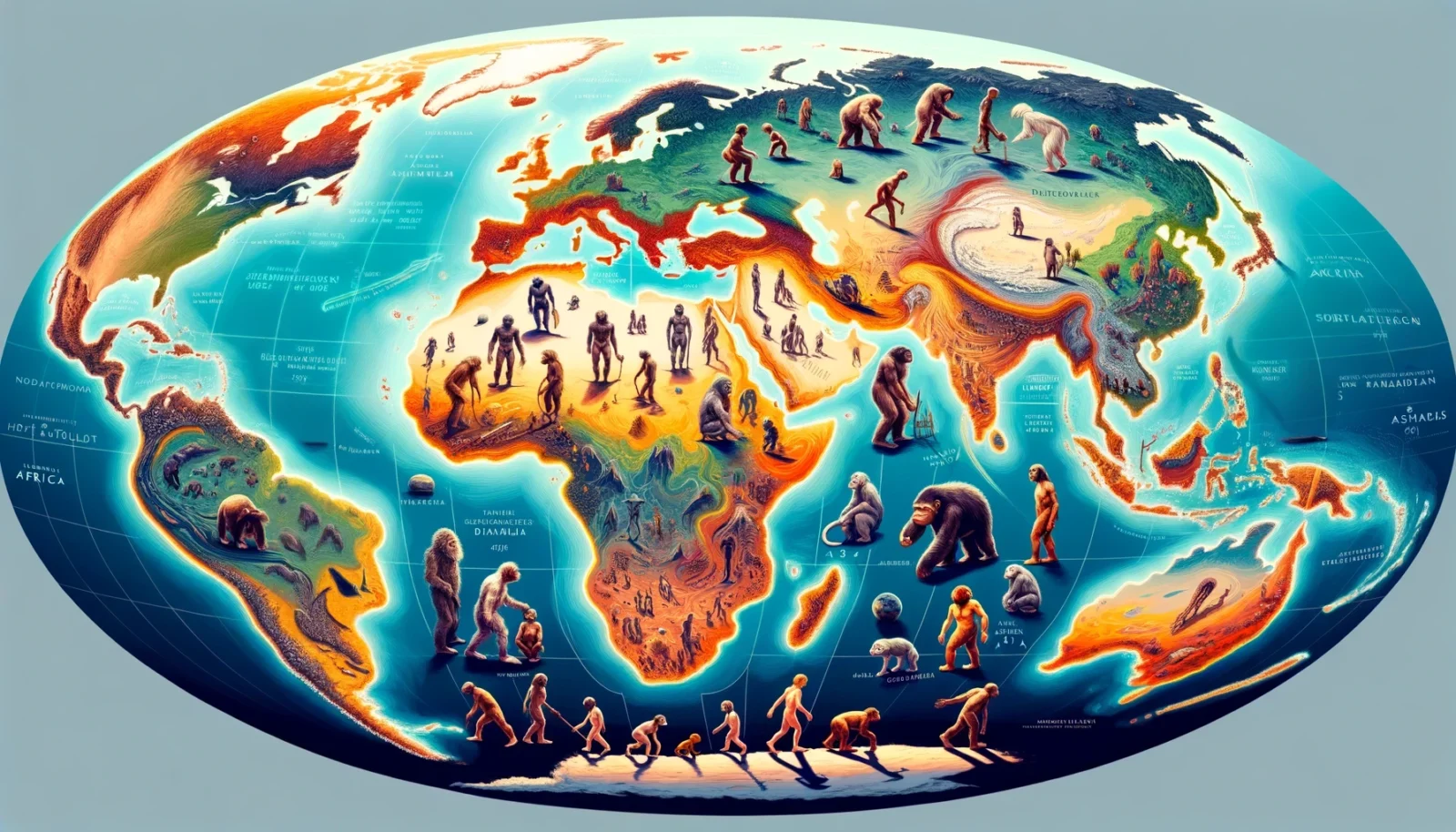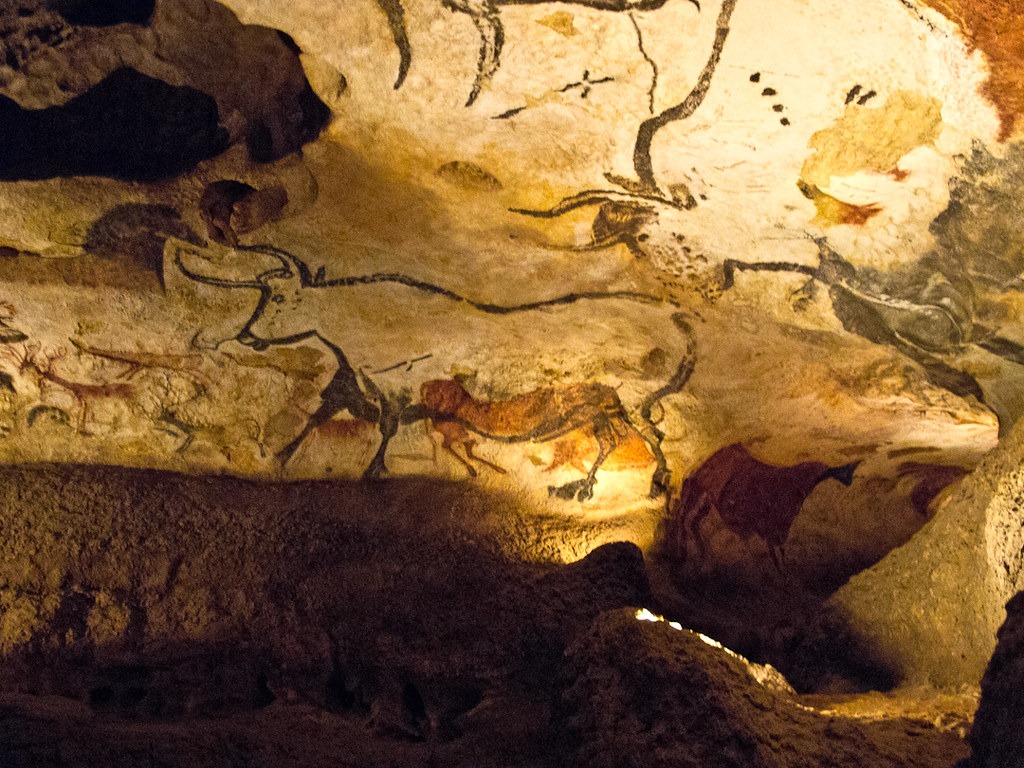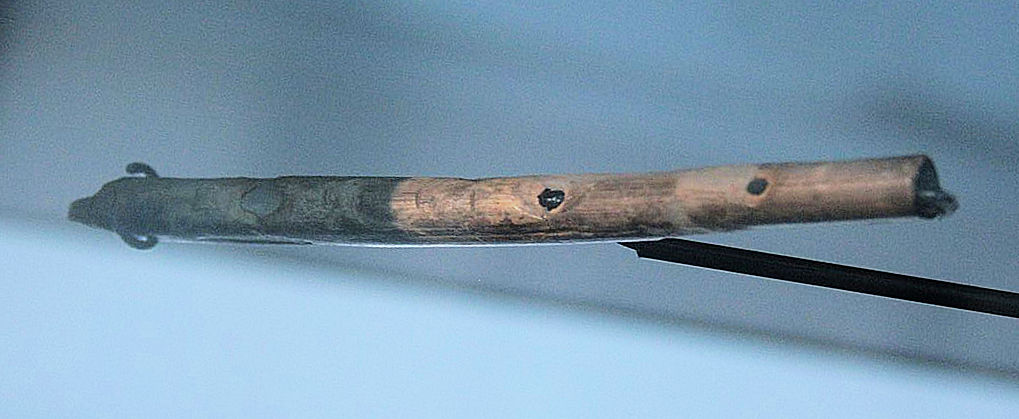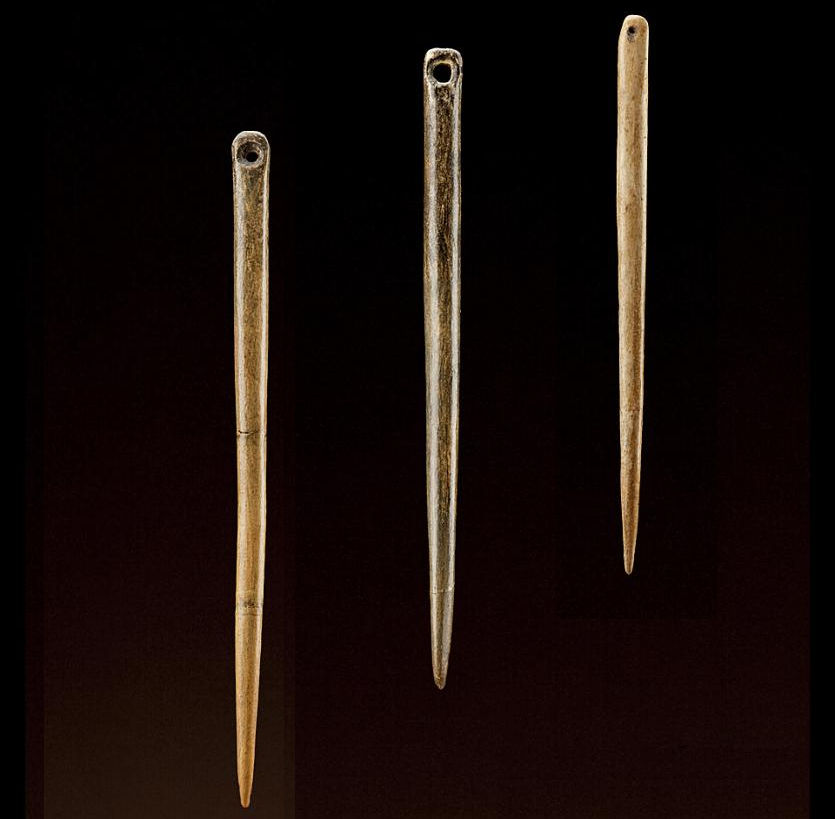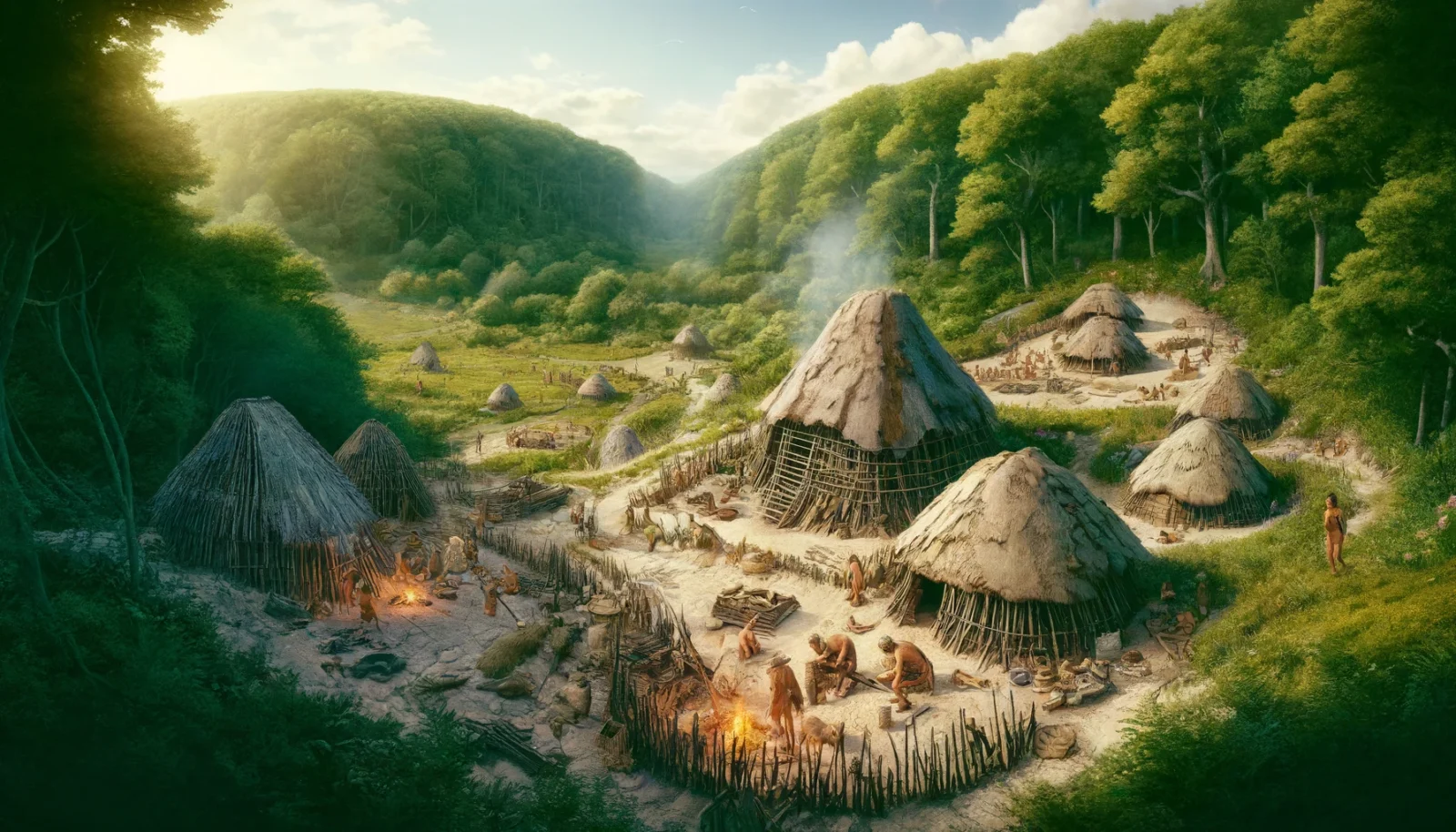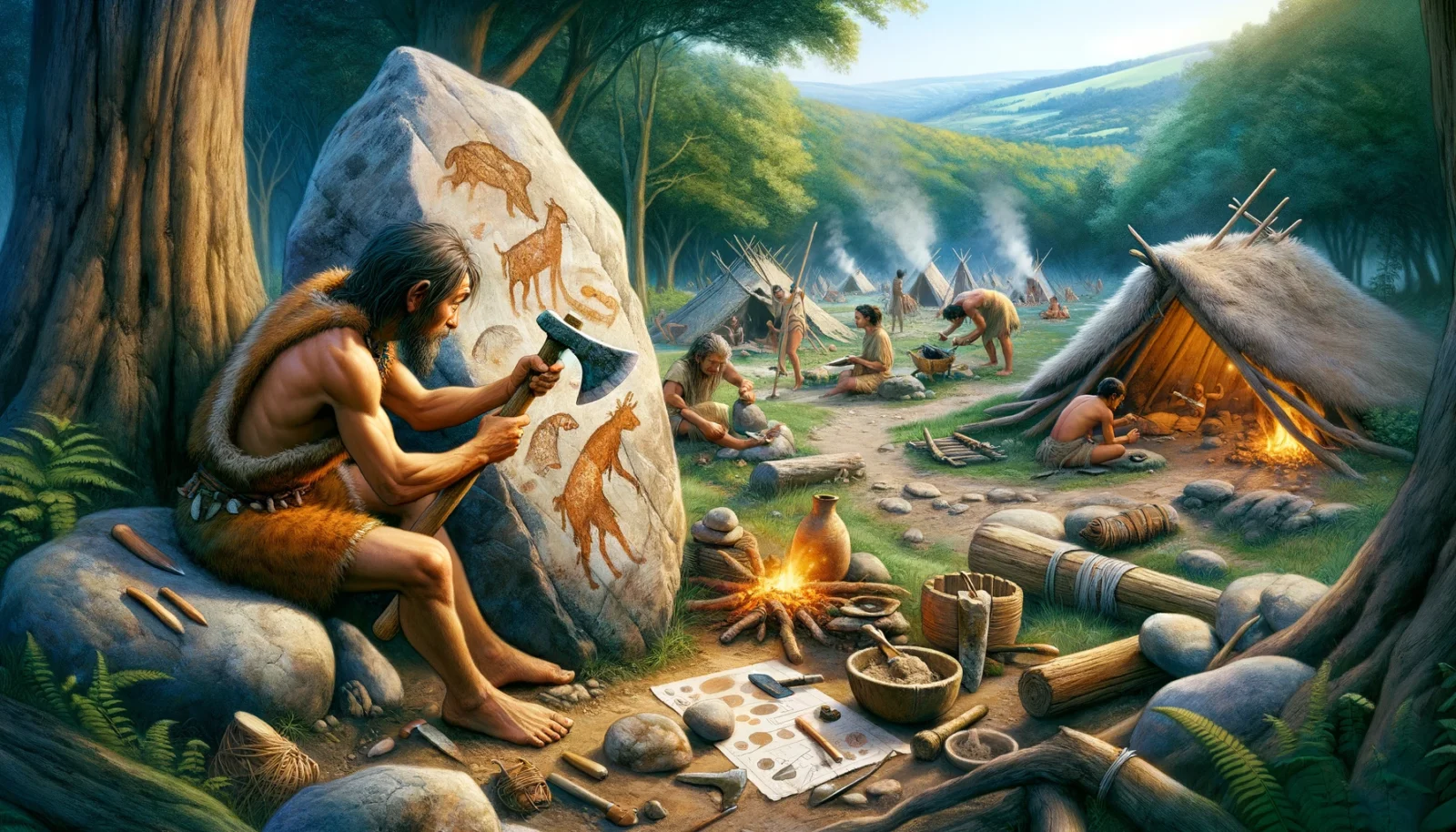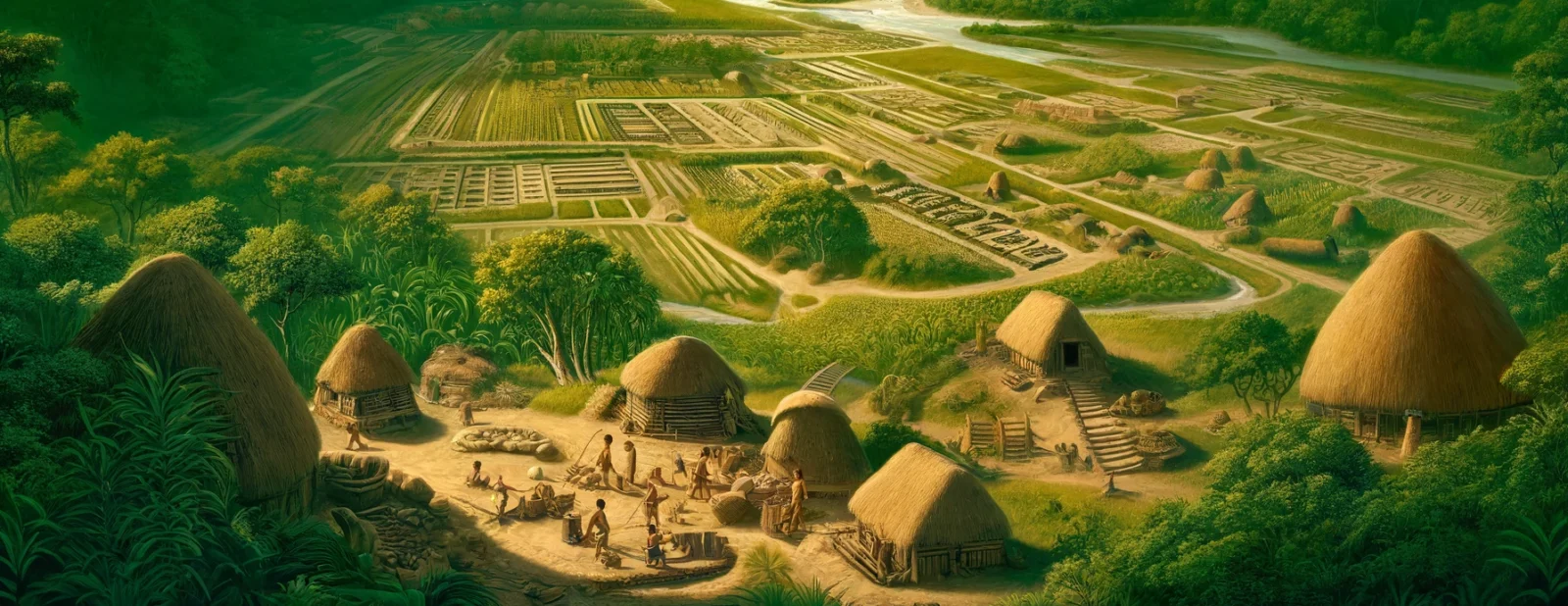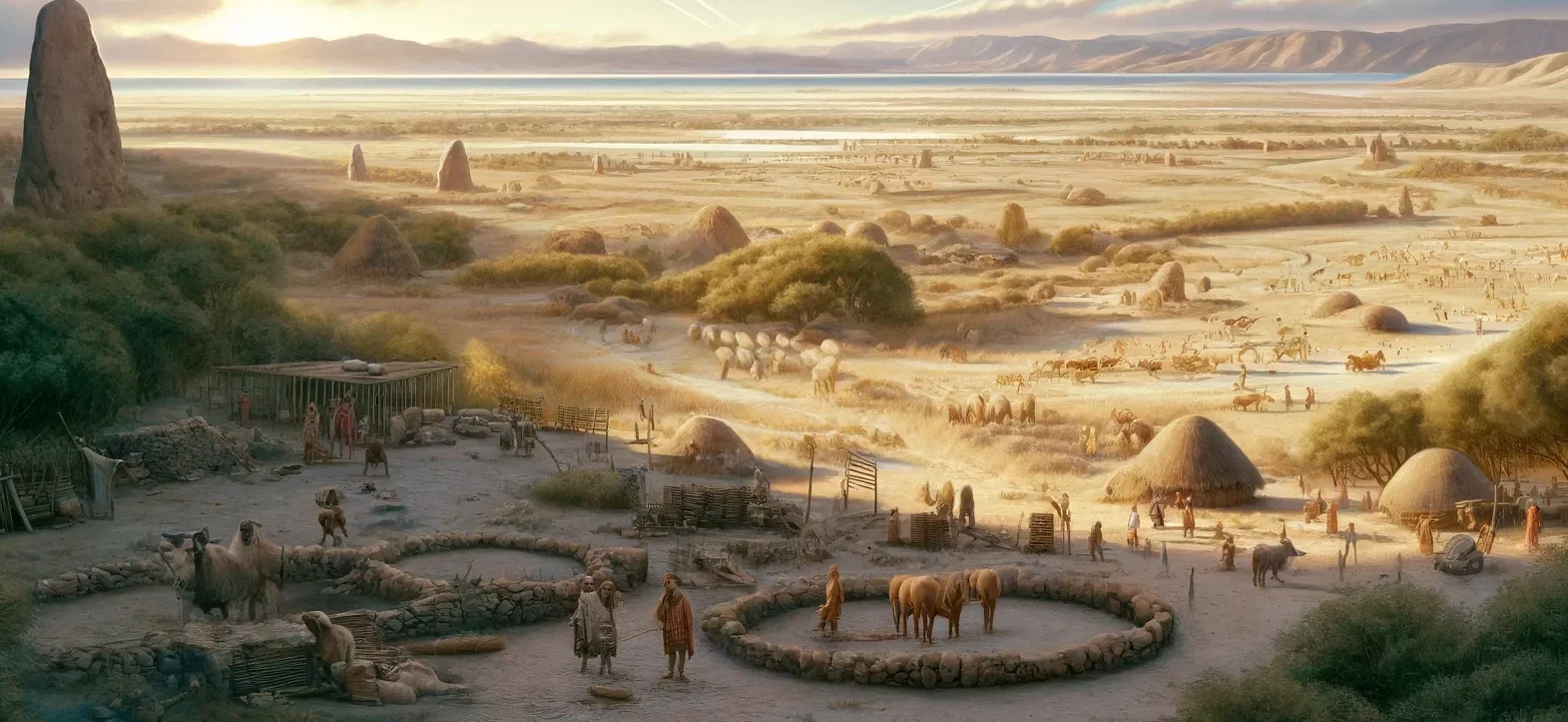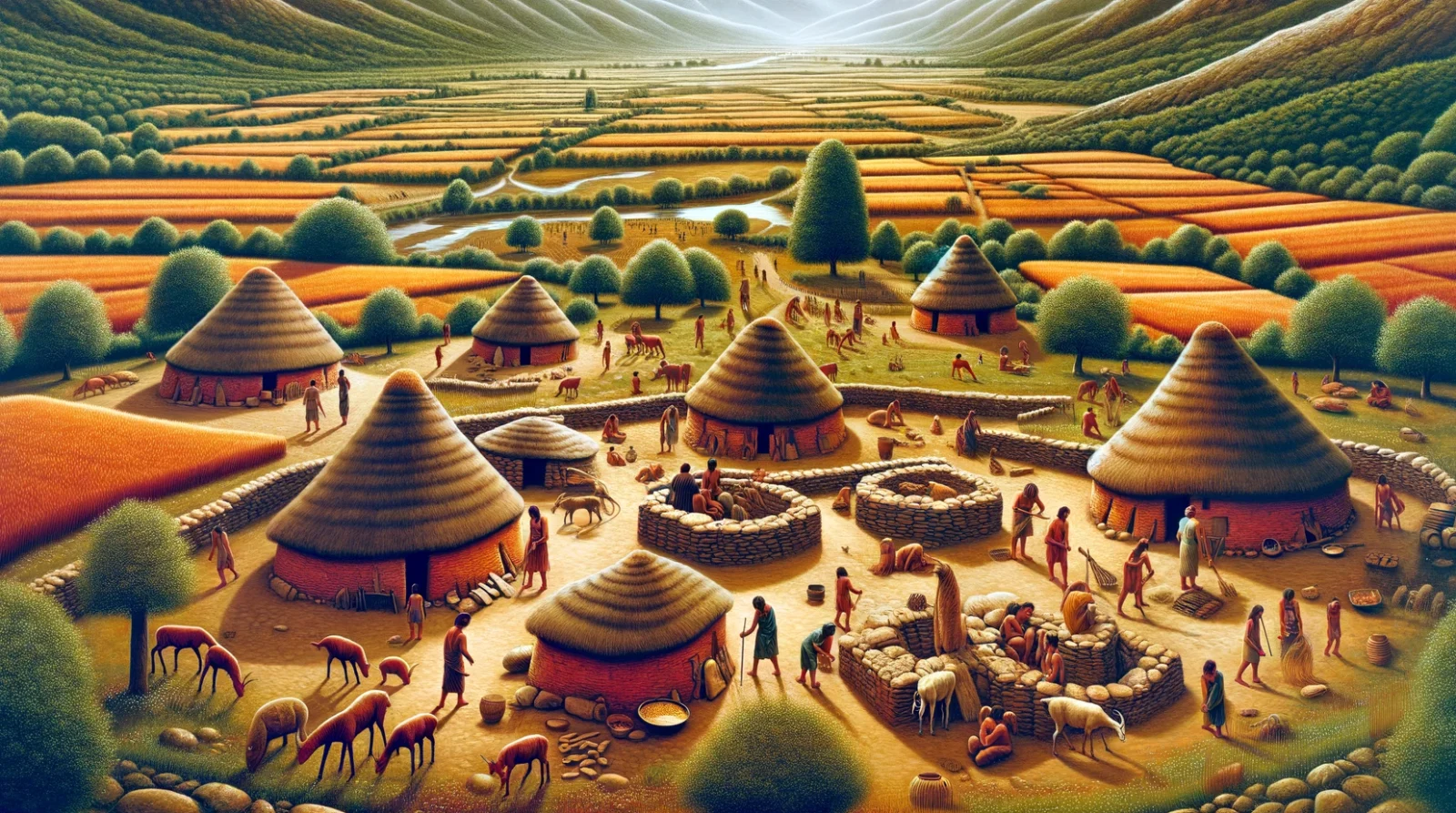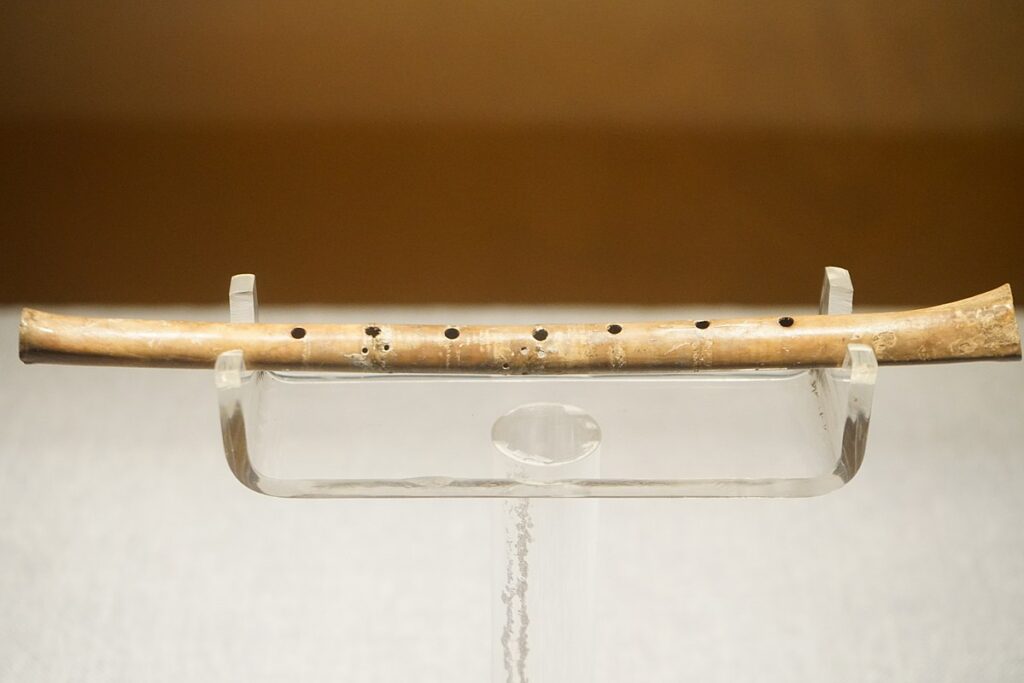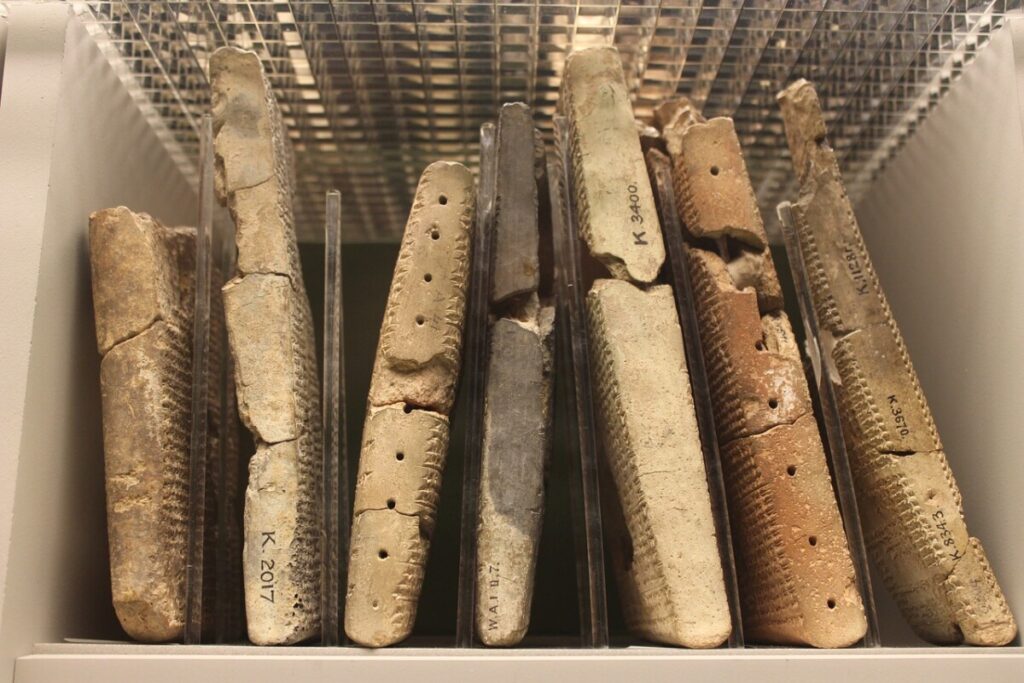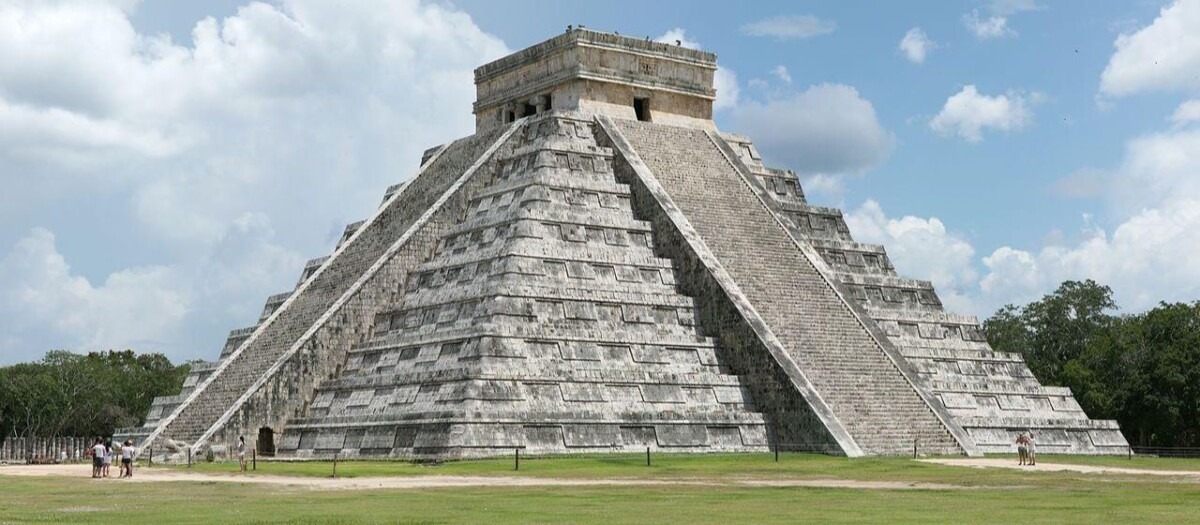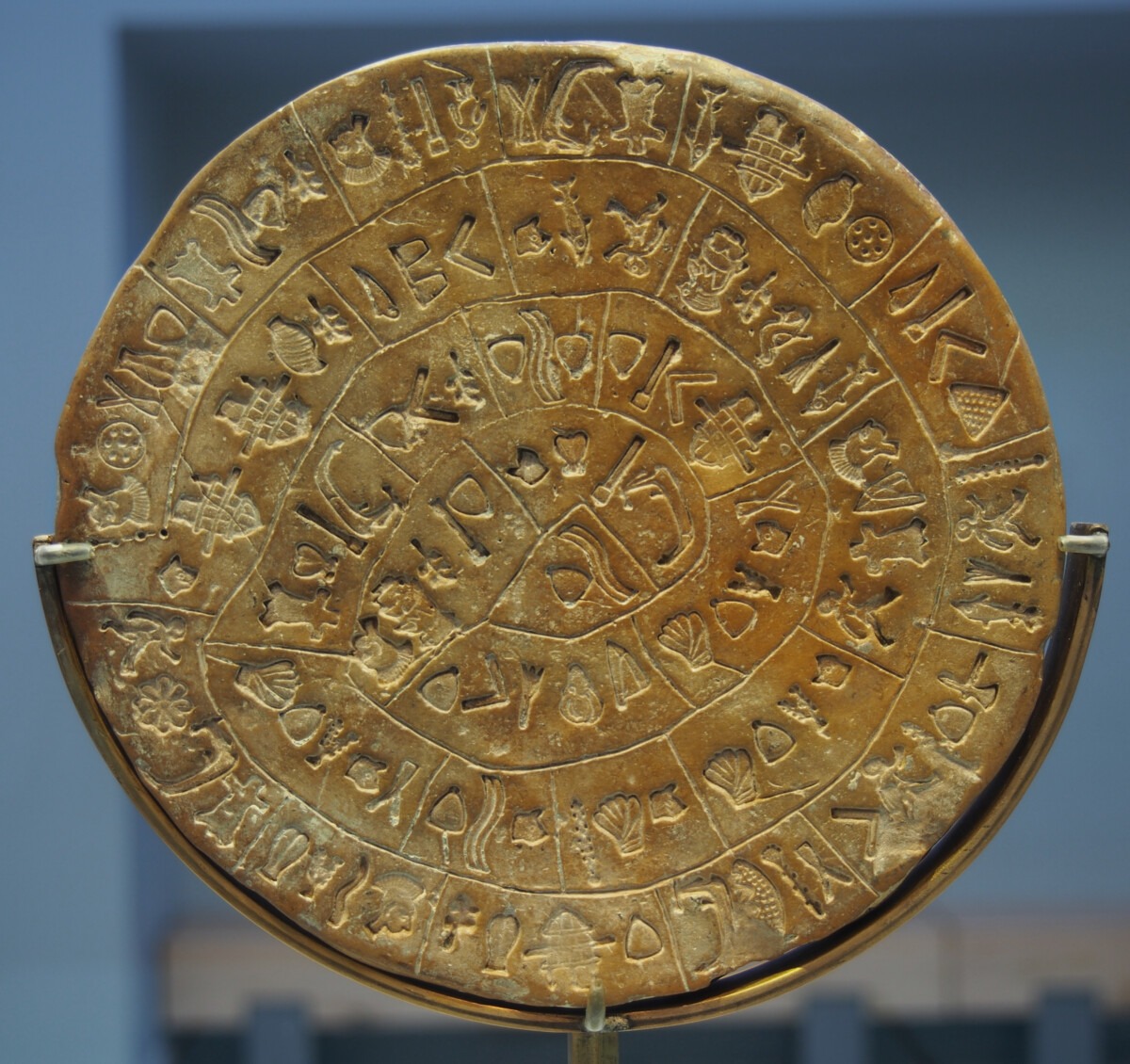March to Civilization: This timeline charts the touchstones of human progress from simple villages to advanced civilizations. While many animals collaborate in groups, humans have taken community and cooperation to unparalleled heights. As humanity evolved from tribes to villages, and eventually to bustling cities, essential cooperative skills were developed. This timeline not only highlights advancements in bartering and dispute resolution but also explores the emergence of verbal language, mathematics, basic logic, and belief systems. Each touchstone marks a significant leap in our ability to live lives enriched by complex social structures and cultural achievements, illustrating how cooperation has been central to our success as a species.
March to Civilization: Societal Touchstones
While speculative, it is reasonable to position the occassional use of proto-medicine as emerging in the great apes sometime around 18 million years ago. Modern orangutans, apes, and chimpanzees treat wounds, digestive issues, and even use insect repellant. The Great Apes LCA lived around 18 million years ago, so using the Occam Approach, this implies that’s around the time such traits emerged. This demonstration of chronoception, a sense of time, is interesting.
This, of course, is only a guess as dog’s and cat’s, which evolved much earlier, frequently eat specific plants to settle their stomach. Some insects, like Ants, use plant extracts to treat fungal infections in their colonies. While the dog and cat example is likely an example of convergent evolution, the ant example for sure is.
Imagined image: By around this time, the great apes could experience time the way we do. They remember the past while living in the present and anticipating the future. In this case, an early great ape is applying mud to a wound he just experienced while anticipating the mud will soothe the pain and help him feel better in the future.
Arboreal to Terrestrial: Beginning approximately 9 million years ago, our ancestors began an evolutionary change from forests to woodlands to savannahs. This gradual transition from primarily arboreal (tree-dwelling) lifestyles to increasingly terrestrial (ground-based) behaviors was very gradual with traits specific for walking around carrying things gradually accumulating. This evolutionary journey spanned roughly 7 million years, culminating in species like Homo habilis, which by about 2 million years ago, had adapted to spend most of their time on the ground and carrying things like stone tools and likely walking sticks which were also used to hunt and fight off animals.
Analysis: The last common ancestor (LCA) of orangutans, which are predominantly arboreal, is dated to around 13 million years ago, whereas the LCA for gorillas, who are more terrestrial, dates to about 8 million years ago. This timeline suggests that around 9 million years ago, the ancestors of modern humans and other great apes began to adapt to life on the savannahs and open landscapes of Africa. As evolutionary paths diverged, each lineage developed distinct adaptations that favored survival on the ground—ranging from changes in limb structure and gait to the development of tools for defense and foraging. By the time of Homo habilis, evidence strongly indicates a lifestyle that was predominantly terrestrial, with occasional returns to the trees for foraging or safety.
Simple wood tools starting with picking up a stick to poke at some out of reach fruit likely paralleled the use of stone tools. Wood tools for the most part did not survive the test of time. The earliest so far include advanced javelins form 400,000 years ago and a digging tool from 780,000 years ago.
Possible, but speculative, progression of wood tools:
By 3.4 mya: hand stick used for poking and defense. A hand stick could be used for poking to gather edible plants, digging small holes, or as a simple defensive tool against predators or rival groups as well as for hunting smaller prey. Chimpanzees today sharpen sticks and kill bushbabies so it’s reasonable to speculate that hominins have been doing similar things going back to at least 3.4 million years ago.
By 3.3 mya: walking stick used for protection and hunting. As early hominins began to traverse more varied terrains, the use of walking sticks could have emerged. These sticks, possibly sharpened at one end, could serve dual purposes: aiding in mobility over rough landscapes and as a rudimentary weapon for hunting small animals or defense.
By 2.6 mya: small sharpened sticks for detailed work. Coinciding with the development of Oldowan stone tools, which included flakes and cores, early humans could have crafted small, sharpened wooden sticks. These sticks would be useful for tasks requiring more precision, such as extracting termites from mounds, piercing to create simple garments from hides, or intricate food preparation like skewering.
By 1.76 mya: Spears and Digging Sticks: With the advent of Acheulean hand axes, there might have been the concurrent use of wooden spears, either fire-hardened or using stone tools to sharpen the tips. These would be essential for hunting larger animals at a distance. Similarly, robust digging sticks could be used for accessing water sources, tubers, or creating simple traps.
By 500,000 ya: Complex Wooden Constructs: By the time Middle Paleolithic tool cultures emerged, there could be more complex wooden constructions such as frames for shelters, more sophisticated spears, and possibly even simple rafts or paddles for navigating waters. The use of fire to harden and treat wood could enhance the durability and effectiveness of these tools.
By 300,000 ya: Hafted Tools and Advanced Spears: The use of adhesives and bindings to attach stone points to wooden shafts likely emerged, producing more effective hafted tools. This period may also see the refinement of spear technology, with better aerodynamics and durability for more effective hunting strategies.
By 200,000 ya: Ritual or Symbolic Wooden Structures: The potential for wooden objects to play a role in ritual or communal activities, such as totem poles or communal meeting structures, reflecting more complex social behaviors and spiritual beliefs.
The earliest known stone tools date back to at least 3.3 million years ago. They are identified by their purposeful flaking patterns, sharp edges, and location with other more identifiable artifacts or fossils. They are then verified with microscopic analysis confirming repetitive use.
Possible Stone-Tool Progression:
By 3.4 mya: Hammerstones, no modification, used for pounding seeds, nuts, or breaking bones.
By 3.3 mya: Lomekwi stone tools. Stone cores, rock flakes removed to reshape, narrow, or sharpen.
By 2.6 mya: Oldowan tools; first definite tools. Stone flakes with sharp edges would used for cutting meat, scraping hides, chopping plants, and wood whittling.
By 2.4 mya: Refinement of Oldowan tools, with more controlled flaking and sharper edges.
By 1.76 mya: Acheulean hand axes, iconic tools with a distinctive teardrop or oval shape for chopping wood, butchering animals, digging, and scraping.
By 1.76 mya: Larger cutting tools such as cleavers for butchering large animals, or heavy-duty scrapers for processing hides or wood.
By 500,000 ya: Middle Paleolithic tools, including pointed hand axes, side scrapers, knife-like tools, and awls for piercing.
By 300,000 ya: Diverse materials such as bone and antler start surviving the test of time. Earliest evidence of composite tools using multiple materials combined to produce tools with specific functions.
By 200,000 ya: Hafted tools, where stone tips are attached to wooden handles, significantly enhancing their effectiveness and range of use.
The dawn of collective learning can be traced back the oldest known stone tools, discovered at Lomekwi 3 in Kenya. The creation of these tools required more than just individual innovation; it involved the rudimentary form of collective learning, where knowledge of toolmaking was shared within groups. This early transmission of skills not only enhanced survival and adaptation but also marked the beginning of cultural accumulation—a fundamental characteristic that would define human societies.
Collective learning is the 6th threshold in Big History. While they place it at about 200,000 years ago, I recrafted it as Trasendental Intelligence and moved it back to 475,000 years. Collective learning, likely started with cultural transmission and the making of tools is a good example. If you agree, then collective learning moves back to at least 3.3 million years ago.
The earliest containers were likely simple natural resources that early hominins stumbled upon and adapted for use. Starting possibly with Homo habilis around 2.0 million years ago, these early humans may have utilized large leaves, shells, or naturally hollowed-out pieces of wood as rudimentary containers. This usage marks an innovative step in early human technology, reflecting an understanding of natural resources for practical purposes.
As hominins evolved, particularly with the advent of Homo erectus, more sophisticated uses of materials likely developed. Homo erectus, known for their tool-making abilities, might have used animal hides to gather and carry items, gradually fashioning them into simple bags or slings. This represents a significant advancement in carrying technology, allowing for the transport of goods over greater distances and supporting more complex foraging strategies.
Before these developments, even earlier hominins may have employed static storage methods, such as piling resources like rocks or wood in designated locations, such as inside caves or on natural ledges. These caches would have served as communal collection points that group members could contribute to and draw from, reflecting early forms of community resource management.
Additionally, the use of vines or strong plant fibers to tie items together suggests the beginning of material manipulation for transport purposes, predating the knowledge of weaving but laying the groundwork for future technological innovations in container making.
The Olduvai Gorge in Tanzania stands as a testament to early human ingenuity and foresight, illustrating a rudimentary form of organizational behavior that predates modern civilization. Utilized extensively over two million years, the site functioned akin to a “factory,” where early humans systematically crafted a variety of stone tools. They strategically selected specific locations that optimized their tool-making efforts. This specialization of space for specific activities suggests a significant cognitive leap—recognizing the efficiency of designated work areas. Such spatial organization reflects the emergence of complex thinking, where early humans not only made tools but also thought strategically about where to make them, hinting at the early development of proto-civilizational structures.
Analysis: Interestingly, remarkably few human remains have been directly associated with the primary tool-making areas. This separation implies that while the site was pivotal for tool production, other aspects of daily life, such as habitation and burial practices, occurred elsewhere. The diverse array of tools found at Olduvai, from simple Oldowan choppers to more advanced Acheulean hand axes, marks significant milestones in technological advancement. The absence of human remains, coupled with the diversity of artifacts, provides crucial insights into the early human capacity for planning, foresight, and possibly, social stratification.
The origins of tent-like structures in human history remain shrouded in mystery, primarily due to the perishable materials involved and the lack of direct archaeological evidence. However, as Homo erectus appeared and spread into varied climates, their enhanced tool-making skills and control of fire likely necessitated and enabled the construction of more complex shelters. This period marks a significant point where early humans may have started to build the first tent-like structures using branches, leaves, and plant fibers to create semi-permanent shelters. The move into cooler environments would have increased the need for such innovations.
Before this timeframe, it’s possible Homo habilis created simple shelters. The emergence of Homo habilis and their use of simple stone tools opens a window of possibility. They might have used vines or branches to create rudimentary windbreaks or lean-tos for temporary protection from the elements.

Earliest known seasonal settlement in the Asian zone: Nestled in what is now the outskirts of Beijing, China, the Zhoukoudian site stands as a testament to some of the earliest forms of semi-permanent human settlement in Asia. The presence of a long-standing fire pit at the center of the site is a significant indicator of repeated use, perhaps up to tens of thousands of years. Around this fire pit, early humans crafted stone tools, an essential skill for their survival and an activity that likely drew groups together.
Other than humans, today’s smartest primates—chimpanzees, bonobos, gorillas, and orangutans—have a combined wild population of approximately 400,000 to 700,000. This number persists despite their near-complete inability to expand beyond their current ideal environments, a restriction not faced by any human species since before Homo habilis. Moreover, this is in spite of the extreme pressures exerted by various human species over the last 300,000 years. Drawing from this, the hominins of 700,000 BCE, including Homo erectus, Homo heidelbergensis, and other yet-to-be-discovered human species, might have had a global population ranging from 1.2 to 2.1 million. While highly speculative, this estimate is plausible, perhaps even conservative, considering Homo erectus‘ widespread presence and success across diverse environments in Africa and Eurasia. This era, significantly before the emergence of modern humans, showcases a dynamic tableau of early human life, marked by significant migrations and adaptations to varying ecological niches. Check out A New Look at Ancient Hominin Numbers: A Speculative Journey for more information.
Full emotional intelligence (EI) likely emerged around this time in species such as Homo antecessor and Homo heidelbergensis. EI heralds the dawn of a new era where emotional intelligence began to take a recognizable shape.
Analysis: With indications of complex social structures, more potential for language, and advanced tool-making abilities, these species navigated their world with a level of social cognition and emotional awareness that surpassed their predecessors. Their ability to cooperate in hunting, share resources, care for the injured or ill, and possibly mourn their dead, points towards an emerging capacity for understanding the emotional states of others, fostering group cohesion and survival.
References
Full Emotional Intelligence:
- Source: Spikins, P. (2015). “How Compassion Made Us Human: The Evolutionary Origins of Tenderness, Trust and Morality.” Pen and Sword.
- Summary: This book discusses the evolution of emotional intelligence and compassion in early humans, providing evidence for the emergence of these traits in species such as Homo heidelbergensis and Neanderthals.
Complex Social Structures and Potential for Language:
- Source: Wynn, T., & Coolidge, F. L. (2011). “How To Think Like a Neandertal.” Oxford University Press.
- Summary: This book explores the cognitive abilities of Neanderthals and their predecessors, including the development of social structures and the potential for language.
Advanced Tool-Making Abilities:
- Source: Arsuaga, J. L. et al. (2014). “The Early Pleistocene Skeleton from the Sima de los Huesos Cave (Sierra de Atapuerca, Spain).” Proceedings of the National Academy of Sciences, 111(16), 6014-6019.
- Summary: This article discusses the advanced tool-making abilities of Homo heidelbergensis, providing evidence of their cognitive sophistication.
Social Cognition and Emotional Awareness:
- Source: Dunbar, R. I. M. (1998). “The Social Brain Hypothesis.” Evolutionary Anthropology, 6(5), 178-190.
- Summary: This paper presents the Social Brain Hypothesis, which posits that the size of the human brain is related to the complexity of social structures and emotional awareness.
Cooperation in Hunting and Caring for Injured:
- Source: Pettitt, P. (2011). “The Palaeolithic Origins of Human Burial.” Routledge.
- Summary: This book provides evidence of early human burial practices and care for the injured, indicating a level of social and emotional cognition.
Emerging Capacity for Understanding Emotional States:
- Source: Tomasello, M., & Call, J. (2007). “The Gestural Communication of Apes and Monkeys.” Lawrence Erlbaum Associates.
- Summary: This book explores the evolution of communication and the understanding of emotional states in primates, shedding light on the early development of these capacities in humans.
Proto-clothing, encompassing basic garments such as animal skins and possibly decorative natural materials, likely emerged among hominins around 600,000 years ago, with Homo heidelbergensis being a probable early adopter. This species, experiencing diverse and often colder climates across Europe and Africa, may have utilized simple clothing as a practical response to environmental challenges.
Analysis: The evidence for early use of clothing, while direct only for Homo sapiens and Neanderthals around 100,000 years ago, can be inferred for earlier hominins through indirect markers. The Last Common Ancestor (LCA) of Neanderthals and modern humans, dating back approximately 600,000 years ago, introduces the possibility that simple forms of clothing might have been in use from this point forward. This assumption is based on the survival needs in varying climates and the sophistication of tool use seen in Homo heidelbergensis. Additionally, the emergence of Homo antecessor around 1.2 million years ago and the sophisticated behaviors observed in Homo erectus, suggest that the use of clothing could be reasonably extended back as far as 1.5 million years ago, albeit more speculatively. Conversely, earlier hominins such as Homo habilis, with their limited tool use and milder environmental conditions, likely did not develop clothing.
Transcendental Intelligence (TI) likely emerged around this time in species like Homo antecessor and Homo heidelbergensis. Species such as these mark a compelling case for the early development of TI: the ability to store information outside the mind and across generations. This would likely take the form of stories, art, or something like a symbolic marking of an area used as a warning to stay away.
Analysis: Although direct evidence of art or jewelry from this era remains elusive, the sophisticated crafting techniques observed in later Neanderthal and Denisovan artifacts, suggest advanced cognitive abilities capable of TI including symbolic thought and advanced tool making. Denisovans are thought to have split from Neanderthals in Europe about 450,000 years ago, and Homo sapiens branched off in Africa about 315,000 years ago. The speculation that TI developed during this time is grounded in the understanding that the cognitive prerequisites for such advancements—complex problem-solving, abstract thinking, and perhaps rudimentary forms of symbolic communication—were likely present.
Big History Thresholds: 1=Big Bang | 2=Stars&Galaxies | 3=Chemicals | 4=Solar System | 5=First Life | 6=TI | 7=Agrarian | 8=Science
Collective Learning: The 6th threshold in Big History is Collective Learning, what I’ve dubbed Transcendenal Intelligence, the storing of information outside our minds. While Big History has this step set about 200,000 years ago as Homo sapiens emerged, I’ve moved it back to Homo heidelbergensis before Neanderthals and us branched off. After the publication of Big History, neanderthal art was discovered, indicating symbolic thought which might imply TI abilities. It’s important to note that very early collective learning likely emerged in Homo habilis or earlier.
Discovered in the 1990s, this 400,000-year-old Homo heidelbergensis structure in France is believed to be a primitive hut or shelter made from wooden posts and branches. The structure is thought to have been built by Homo heidelbergensis. The shelter is estimated to be around 4-5 meters (13-16 feet) wide and 6-7 meters (20-23 feet) long. It’s believed to have been constructed using a simple framework of wooden posts, with branches and leaves used to create a roof and walls. While the above image is a minimalist artist representation, the following is more likely what their camp looked like.

When Homo sapiens first emerged, their population in Africa was likely just a few hundred thousand, while the total hominin population, including other species like Neanderthals and Homo heidelbergensis, may have ranged from 1.1 to 2.1 million. During this period, Homo sapiens were primarily found in Africa, while other hominins occupied broader ranges across Eurasia, with Neanderthals and Denisovans adapting to their environments with sophisticated tool-use and social structures. The early hominin distribution and interaction remain unclear, and this narrative, while speculative, helps us imagine the ancient world, highlighting the need for caution in interpreting these ancient population dynamics. Check out A New Look at Ancient Hominin Numbers: A Speculative Journey for more information.
Earliest known seasonal settlement in the Africa/Middle East zone: In the diverse and rich landscapes of what is now South Africa, the Klasies River Caves served as a vital seasonal haven for early modern humans.
Positioned strategically along the coast, these caves were revisited across generations, suggesting a shared understanding among different groups about the benefits of this location. The community constructed simple yet effective shelters from branches and animal hides just outside the cave entrances, creating a setup that supported daily activities such as tool crafting, hide preparation, and communal cooking over open fires.
This pattern of seasonal settlement allowed for the efficient exploitation of local resources, minimizing the need for constant movement and enabling a more sustainable living arrangement. It fostered not only survival but a thriving community life where knowledge, skills, and social bonds were developed and strengthened.
The archaeological remains and artifacts from the Klasies River Caves—ranging from sophisticated stone tools to evidence of hearths and human remains—illustrate a complex social structure that predates agricultural societies. These findings highlight the ability of early humans to adapt to their environment through cooperative behaviors and strategic planning, showcasing a level of communal life and environmental management that speaks to the enduring human spirit and intellectual vigor comparable to that of contemporary societies. This site provides a profound glimpse into one of humanity’s earliest known attempts at semi-permanent living, underscoring the sophisticated social dynamics that underpinned pre-agrarian human settlements.
Imagined Image: The image of the semi-nomadic people of South Africa depicts a group of up to 50 individuals congregating here around 100,000 years ago, establishing a semi-permanent settlement that utilized the natural shelter provided by the caves and the abundant resources of the surrounding area.
.
Denisovan: This bracelet dates from 70,000 to 40,000 BCE. It was discovered inside the Denisova Cave beside ancient human remains. The Denisova Cave is a cave located in Siberia, Russia. Other cave finds include woolly mammoth and woolly rhino bones. Scientists say there is evidence that the bracelet’s maker used a drill. This is the earliest known example of advanced drilling in the world.
Head of the museum Irina Salnikova said: ‘The skills of its creator were perfect. Initially we thought that it was made by Neanderthals or modern humans, but it turned out that the master was Denisovan.” This has led to speculation that these earliest humans, Denisovans, were more technologically advanced than previously thought. If true, it might be that the Denisovans were more skilled than Homo sapiens and Neanderthals of the time.
Like Neanderthal DNA, Denisovan DNA exists in modern humans. Non-African East Asians and Europeans have about 2% Neanderthal DNA. Modern Melanesians derived about 5% of their DNA from Denisovans.
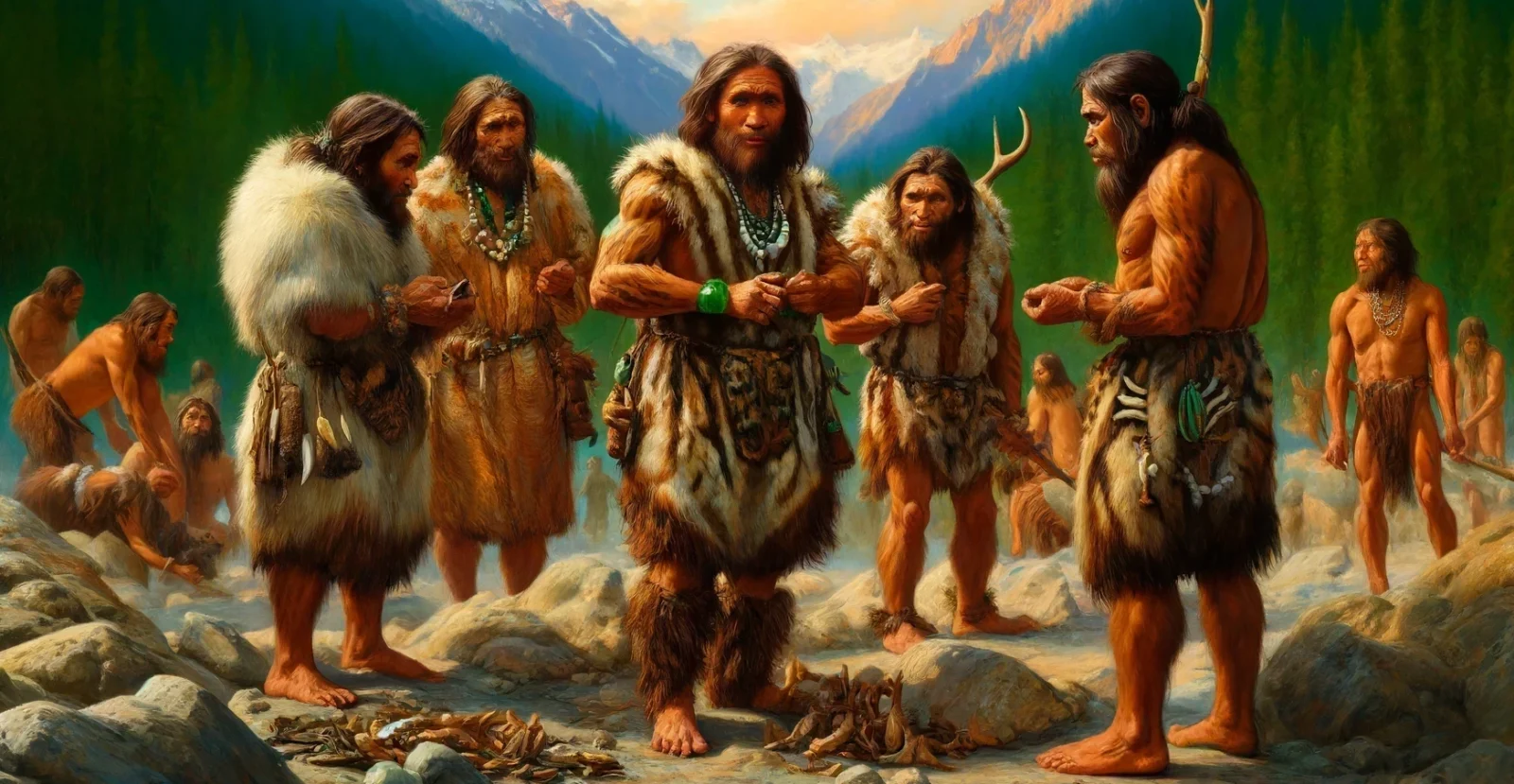
The Sentinelese are believed to have been isolated since the last major initial human migrations out of Africa 60 to 70 thousand years ago. Their isolation has likely preserved unique genetic traits. The Sentinelese are related to other indigenous peoples of the Andaman Islands, such as the Onge, Jarwa, and Great Andamanese. Studies on these groups indicate that they have some of the earliest genetic markers found in Asia. The genetic diversity among the Andamanese tribes, including the Sentinelese, is thought to be low due to their small population sizes and long-term isolation. Due to their isolation, the Sentinelese may lack immunity to common diseases found elsewhere–a significant concern.
Cognitive Revolution
50,000 BCE – 70,000 BCE. Population range: 500,000 to 2.5 million.
Given the uncertainties and lack of direct data, the following are speculative estimates.
- Africa-Middle East: 50-60% or 600,000 to 1 million people
Africa, being the origin of modern humans, likely had the highest population density at this time, particularly in Sub-Saharan regions which were more conducive to human habitation due to their climate and available resources. - Asia: 40% or 200,000 to 400,000 people
- Europe-Mediterranean: 10% or 50,000 to 100,000 people
- The Americas: 0.
- Oceana-Australasia: 1% or 10,000 to 15,000 people
The initial colonization of Australia around 50,000 BCE by modern humans involved small, isolated groups who managed to navigate sea crossings, leading to a very low initial population density. The rest of the remote islands of Oceania were among the last to be reached by humans.
A Shared Earth! Neanderthals-Hobbits-Flourensis
Around this time, Homo sapiens shared the Earth with other hominin species. Neanderthals were still widespread in Europe and parts of western Asia. In Asia, particularly on the islands of Indonesia, Homo floresiensis, often referred to as the “Hobbit” due to their diminutive stature, survived until about 50,000 years ago. Additionally, Denisovans, a less visually documented but genetically distinct group, also roamed Eurasia, leaving behind a genetic legacy that persists in modern humans, particularly among populations in Melanesia.
The sea offers tremendous resources and stability. The rising and receding oceans continue to destroy the homes of many. How many unknown cultures in our vast history thrived on the coast for millennia?
The site discovered off the coast of Cuba, also known as the “Cuban Underwater Pyramids,” includes pyramid-like structures and other geometric formations identified using sonar and underwater robots by the research team led by Paulina Zelitsky and Paul Weinzweig. This site, submerged at a depth of around 650 meters, has sparked debate and speculation about its origins, with some suggesting it could be remnants of an ancient civilization dating back more than 50,000 years, while others argue it might be a natural geological formation. Further research is needed to uncover the true nature of these intriguing structures.
Earliest known symbol use in the Europe/Mediterranean zone.
Dating back to around 40,000 BCE, the Upper Paleolithic cave art found across Europe presents a compelling narrative of early human communication and symbolic expression. Sites like Lascaux in France and Altamira in Spain feature elaborate depictions of animals, human figures, and abstract symbols that recur with remarkable consistency across diverse regions. These symbols, including dots, lines, and geometric shapes, suggest a standardized usage that transcends mere artistic decoration. Researchers speculate that these symbols may have served proto-writing functions, possibly representing early attempts to record important information such as seasonal changes, ritual practices, or social codes.
Eastern Asia and Europe: The domestication of dogs marks one of the most remarkable and earliest examples of animal domestication by humans. This significant event occurred approximately 20,000 years ago, with some studies suggesting an even earlier date. The process began when wolves, drawn by the waste and remnants of hunting left by human groups, started to linger around the fringes of hunter-gatherer camps. Over time, a mutual relationship developed: these ancestral wolves provided humans with alertness to dangers and help in hunting, while humans provided a steady food source.
The transformation from wild wolves to domesticated dogs likely took place in several regions independently, but genetic evidence points to significant early domestication events occurring in Eastern Asia and Europe. Through a natural and then increasingly intentional process of selection, humans favored wolves that exhibited traits beneficial to their lifestyle—traits like reduced fear and aggression, which made them better companions and guards. This led to genetic divergence from their wild counterparts, morphing wolves into various forms and breeds of dogs as we recognize them today.
These early dogs were not just pets but integral to human societies, assisting in hunting, guarding territories, and providing companionship. Their roles expanded as human societies grew more complex, with dogs adapting to various climates and cultural expectations. The domestication of dogs not only highlights the adaptability and intelligence of these animals but also underscores the deep, symbiotic relationship that developed between two distinct species, setting the stage for the later domestication of other animals and the rise of agrarian societies.
Earliest known seasonal settlement in the European Mediterean zone: Nestled in the Argolid region of the Peloponnese in Greece, the Franchthi Cave offers a unique window into the lives of early Europeans spanning from the Upper Paleolithic through the Mesolithic and into the Neolithic periods. For over 23,000 years, from about 20,000 BCE to 3,000 BCE, this cave served as a seasonal hub for prehistoric communities.
The strategic coastal location of the Franchthi Cave allowed early humans to exploit both marine and terrestrial resources effectively. The abundance of marine shells and fish bones found within the cave layers suggests that these groups were highly adept at fishing and shellfish gathering, activities that likely formed a significant part of their subsistence strategy during their stays.
As seasons turned, these early inhabitants would have utilized the cave as a base from which to conduct their hunting and gathering activities. Over millennia, the evidence shows a gradual shift from reliance on wild resources to the introduction of domesticated plants and animals, signaling the start of agricultural practices in the region.
This transition marks Franchthi Cave not just as a site of temporary habitation but as a pivotal location where significant cultural and technological transformations occurred. The cave’s extensive use and the layers of habitation offer profound insights into the evolutionary journey of human societies in the Mediterranean, showcasing how a simple seasonal settlement could eventually evolve into a cornerstone of early agrarian life.
Franchthi Cave thus represents one of the earliest known seasonal settlements in the European-Mediterranean zone, providing invaluable lessons on the adaptability and innovation of early human communities in the face of changing environmental and social landscapes.
Imagined image: This image portrays a seasonal settlement at Franchthi Cave around 10,000 BCE, where early humans utilized natural materials to construct temporary shelters nestled within a lush landscape. Central hearth areas serve as communal hubs for cooking and social gatherings, illustrating the strategic use of space and resources by these early inhabitants. The arrangement of shelters around the cave entrance highlights their reliance on the natural environment for survival and community activities.
The Mezhyrich community thrived in Ukraine, living in huts built from mammoth bones. These resourceful people used mammoth skulls, tusks, and bones to construct shelters covered with animal skins. They engaged in daily activities such as cooking, tool-making, and socializing, showcasing a harmonious, bustling life. The nearby rivers provided resources and sustenance, while their sophisticated structures indicated advanced social organization and cooperation.
Earliest Known Semi-Permanent Settlement in the Americas: Located in the lush landscapes of southern Chile, Monte Verde marks one of the earliest known human settlements in the Americas. Dating back to around 14,800 years ago, this site provides compelling evidence of early human ingenuity and adaptability far from the commonly accepted Eurasian cradles of civilization.
The archaeological remains at Monte Verde reveal a picture of a well-established community, whose inhabitants constructed semi-permanent structures using local materials such as wooden stakes and animal hides, combined with an array of insulating local vegetation. This level of architectural development suggests a shift from nomadic lifestyles to more settled, albeit seasonally influenced, habitation patterns.
Monte Verde is distinguished not only by its age but also by the variety of artifacts discovered on site, including tools, remnants of wooden structures, and evidence of medicinal plant use, indicating a sophisticated understanding of the local environment. The presence of these items points to a diversified economy, with a blend of hunting, gathering, and possibly early forms of plant processing that would precede true agriculture.
This settlement reflects a significant phase in human migration and adaptation, showcasing how early peoples in the Americas were able to create enduring communities in challenging new landscapes. Monte Verde stands as a testament to the resilience and resourcefulness of these early Americans, highlighting a pivotal moment in the march of civilization across continents.
Significance: Monte Verde challenges previous conceptions about the timing and progress of human settlements in the New World, pushing back the dates of human presence in the Americas and showing an advanced level of social and technological development long before the widespread adoption of agriculture. This site helps us understand the complexity of early human societies and their capacity to adapt to and thrive in diverse and distant environments.
Imagined Image: Monte Verde site around 14,800 BCE showing a thriving early human settlement in a lush forested environment, with semi-permanent structures and a community engaged in daily activities.
Late Stone Age
Mesolithic Period: 10,000 BCE – 6000 BCE.
- Africa-Middle East: 30% or 1.2 million peopleg
- Asia: 40% or 1.6 million people
- Europe-Mediterranean: 15% or 600 thousand people
- The Americas: 10% or 400 thousand people
- Oceana-Australasia: 5% or 200 thousand people
Earliest known permanent settlement in the Africa/Middle East zone.
Jericho, located in the West Bank, Palestinian Territories, stands as one of the earliest known permanent settlements in the Africa/Middle East zone, with continuous habitation dating back to at least the 9th millennium BCE. Situated near an oasis in the Jordan Valley, Jericho’s strategic location provided access to vital water sources, facilitating agriculture and sustaining human settlement.
Permanent Settlement Note: This early permanence challenges traditional notions of settlement patterns, showcasing the importance of water in the establishment of communities. It’s worth noting that while Jericho is among the earliest known permanent settlements, there may be even earlier settlements nestled along lakeshores or rivers, but their discovery is hindered by the very element that made them attractive to ancient peoples: water.
Earliest known agrarian society in the Americas zone: In Oaxaca, Mexico, the site of Guilá Naquitz provides evidence of early plant domestication, particularly of squash, around 8000 BCE, with subsequent developments including maize and beans.
Imagined Image: An early agrarian society of Oaxaca, Mexico, circa 7900 BCE. It showcases small, temporary shelters, with indigenous people engaged in early farming practices.
Big History Thresholds: 1=Big Bang | 2=Stars&Galaxies | 3=Chemicals | 4=Solar System | 5=First Life | 6=TI | 7=Agrarian | 8=Science
Agriculture: The 7th threshold is agrarian societies which allowed for complex structured urban cities.
Earliest known agrarian society in the Africa/Middle East zone: Located in southern Egypt, Nabta Playa is one of the earliest known agrarian societies in the Sahara. This prehistoric community developed a sophisticated system of cattle herding and possibly small-scale cultivation, alongside seasonal water management strategies, making it a precursor to more complex agricultural societies in the Nile Valley.
Imagined Image: The image of the semi-nomadic Nabta Playa around 7400 BCE depicts a semi-arid landscape with sparse vegetation, where early inhabitants manage small herds of cattle and engage in rudimentary agriculture. Simple stone structures and megalithic arrangements suggest the beginnings of organized social and ritual practices in a seasonally used settlement.
If Fuxi existed as one person, that person likely lived sometime between 8000 and 7000 BCE. Fuxi is a legendary figure in Chinese mythology, considered one of the Three Sovereigns. He is credited with creating humanity, inventing writing, and teaching people to fish and hunt. Fuxi’s contributions laid the foundation for early Chinese civilization and culture, embedding the importance of knowledge, survival skills, and societal organization in Chinese thought.
If Nüwa existed as one person, that person likely lived sometime between 8000 and 7000 BCE. Nüwa is a mother goddess in Chinese mythology, often associated with Fuxi. She is credited with creating mankind and repairing the pillar of heaven, symbolizing the restoration of order in the universe. Nüwa’s story highlights themes of creation, nurturing, and the balance between chaos and order, which are integral to early Chinese cosmology and philosophy.
Earliest known agrarian society in the Europe/Mediterranean zone: The Sesklo culture in Greece is recognized for its early adoption of agriculture, including the cultivation of cereals and legumes, and domestication of animals. This Neolithic culture is noted for its distinctive pottery and advanced housing architecture, reflecting significant societal organization.
Imagined image: The Sesklo Culture village around 7400 BCE, featuring sturdy mud-brick houses with thatched roofs, organized around a communal area, set in a lush, agriculturally rich landscape. This early Neolithic settlement in Greece exemplifies one of Europe’s first transitions to a settled, agrarian lifestyle.
Potential earliest writing in Asian zone: the Oracle Bone Script, circa 1250 BCE is oldest confirmed.
These symbols which are radiocarbon dated to the 7th millennium BCE have similarities to the late 2nd millennium BCE oracle bone script. Put this writing in the MAYBE column. Scientists are still going through a process to verify this claim. If we can discover some intermediate links, yes, more missing links, we can firm up these symbols as early writing. They were discovered in 2003 on tortoise shells found in 24 Neolithic graves excavated in Jiahu, Henan province, northern China.
Earliest known agrarian society in the Asia zone: Located in Henan, China, Jiahu is one of the earliest sites showing comprehensive signs of early agriculture, including rice cultivation. The community also showed advanced practices like winemaking, music, and possibly writing, indicating a highly developed early agrarian society.
Imagined image: This panoramic image presents the Jiahu Settlement around 7000 BCE, capturing a vibrant Neolithic village in Henan, China. It features typical mud and wood homes with thatched roofs, nestled in a lush landscape where inhabitants are engaged in the early cultivation of rice, illustrating the dawn of agriculture in ancient China.
Earliest known agrarian society in the Oceana-Australasia zone: Kuk Swamp in the Highlands of Papua New Guinea provides evidence of early agricultural innovation, including ditched drainage systems for taro cultivation. This represents one of the earliest known instances of agriculture in Oceania, showing complex environmental management by its inhabitants.
Imagined image: The Kuk Early Agricultural Site around 7000 BCE in the highlands of Papua New Guinea, showcasing a landscape marked by sophisticated drainage systems and irrigated taro fields. The typical homes, constructed from bamboo and thatch and elevated on stilts, reflect the innovative adaptations of this early agrarian community to their wet, mountainous environment.
Atlit Yam is a captivating ghost town submerged beneath the Mediterranean Sea off the coast of Israel. This ancient Neolithic village, dating back over 9,000 years, offers a unique window into the lives of these coastal inhabitants. Abandoned in a hurry, the site was left with many belongings and food sources still intact, offering a unique glimpse into the lives of its ancient inhabitants. Preserved by the watery tomb, the site reveals a vibrant community that thrived around 6900 to 6300 BCE, relying on both land and sea. Archaeologists have uncovered well-preserved houses, tools, and even human remains, painting a vivid picture of daily life in this prehistoric settlement.
While no writing was found, the site has yielded various forms of art and symbolic expression including geometric stone tiles, carved stone figurines, rock art, and personal adornments.
- Under sea preservation: unique and well-preserved finds.
- Copper artifacts (early metalworking)
- Oldest known cases of tuberculosis.
- Elaborate ritual structures
- Sophisticated water management systems (including a freshwater well)
- advanced social structure
- advanced technology for the time
Interpreting the date God created the Earth by reading and interpreting the Bible is very difficult. You can put dates on events, time between events, etc. then convert it to the modern Julian calendar. One popular interpretation is Sunday, October 23, 4004 BCE. Generating this date, and similar, rely on the Ussher chronology technique. The Ussher chronology technique comes from the 17th-century Archbishop James Ussher. Ussher created a chronology of the history of the world formulated from a literal reading of the Old Testament. Updates and various interpretations along the same lines are frequently lumped under Ussher chronology.
Others not specified.
- Islam: No creation date implied.
- Chinese mythology: No creation date implied, early time is more symbolic.
- Ancient Egyptian: No creation date implied, early time is more symbolic.
Estimating the date of Earth’s creation according to Judaic tradition involves delving into the Hebrew Bible and rabbinical interpretations. A significant historical calculation places the creation at 3761 BCE, marking the beginning of the Hebrew calendar. This date is derived from the Seder Olam Rabbah, a 2nd-century CE chronology that counts the generations and events as described in the Tanakh (Hebrew Bible). Unlike interpretations that might visualize detailed scenes, Judaic tradition emphasizes an abstract representation of creation, focusing on God’s divine utterance as the world is brought into existence. This reflects the core Jewish belief in an incorporeal and unseen God, where creation is viewed through the lens of spirituality and the mystical qualities of the divine word. The Hebrew calendar, which currently dates back to this creation, is more than just a measure of years; it is a continuum of spiritual history, deeply rooted in the Judaic understanding of time and creation.
Earliest known writing in Africa/Middle East zone.
Human DNA today is the same as 50,000 BCE. There is no doubt there were many dozens and perhaps thousands of civilizations prior to the Sumer civilization, but Sumer is the earliest known, or at least the earliest well known. The Sumer civilization first established between 6500 and 4100 BCE. We know quite a bit about the Sumerians because they immortalized their writing in clay tablets which will be around long after all the paper books on Earth right now have deteriorated. Sadly, we know almost nothing about prior civilizations because very little evidence survived the test of time. The Sumerians spoke and wrote Sumer and starting several millennia into their civilization they started immortalizing their culture on clay. They had an advanced democracy with elected officials, religion, art, wheel, math, philosophy, and language. The Cuneiform script was in use until 100 CE.
The oldest known dice date back to around 3100 BCE in Scotland. While it’s possible the idea of dice was invented many millennia ago, it’s more likely that dice are an example of convergent invention and traveling news. Dice were likely invented and lost to the sands of time many times over at least the last 100,000 years.
The earliest known dice so far were bone dice found at the site of the Neolithic village of Skara Brae in Orkney, Scotland. They were used sometime between 3100 and 2400 BCE. The dice have been decorated with combinations of notches, grooves, and dots (pictured above). This settlement was buried in sand, thus preserving buildings and a range of everyday objects. The inhabitants used bone and antler as a raw material for a range of objects including shovels, awls, pins, knives, and even beads.
In the Mesopotamian region, the oldest known dice date back to around 3000 BCE. They were found in the Burnt City (Shahr-e Sukhteh) in Iran. These ancient dice were made from various materials like bone and stone, and they have been found in association with other early gaming artifacts.
Within four centuries, news of this entertainment traveled east 750 miles to the Indus Valley Civilization, navigating harsh landscapes, political, and social barriers. The Indus Valley dice date back to about 2600 BCE. The evidence suggests that dice were in wide use in multiple areas for at least centuries and likely for millennia. Either way, from here, news of dice would take about two millennia to reach distant places like China. Asian dice date back to about 600 BCE. It’s also possible that dice in China were invented separately as another example of convergent invention.
Stone Copper Age
Chalcolithic Period: 3,000 BCE – 500 BCE.
- Africa-Middle East: 36% or 5 million people
Early civilizations include Egypt and Mesopotamia with a relatively higher population density. - Asia: 36% or 5 million people
Early civilizations include Indus Valley and ancient China. They saw early urban development and agriculture which supported larger populations. - Europe-Mediterranean: 14% or 2 million people
Smaller due to the varied climatic conditions and the later development of agriculture compared to the Middle East. - The Americas: 7% or 1 million people
More sparsely populated with many diverse hunter-gatherer communities and early agricultural societies, particularly in regions like Mesoamerica. - Oceana-Australasia: 7% or 1 million people
These regions were among the least densely populated, with scattered tribal groups primarily leading hunter-gatherer lifestyles.
The Fuente Magna Bowl, discovered in 1950 near Lake Titicaca, Bolivia, is a large stone vessel with intricate carvings. Unearthed by a local farmer, the bowl was later donated to a small local museum and eventually transferred to the Museum of Precious Metals in La Paz. The bowl features engravings that some claim resemble ancient Sumerian cuneiform and other proto-scripts. This artifact’s intricate carvings have sparked significant interest due to their apparent similarity to writing systems used thousands of miles away in ancient Mesopotamia.
It might be a modern forgery, but if not, the Fuente Magna Bowl is significant because it might point to a Sumerian-South America connection or to earlier proto-writing. Experts like Dr. Clyde Ahmed Winters have proposed that the inscriptions are Proto-Sumerian, suggesting possible ancient transoceanic contact. However, many scholars are skeptical, citing inconsistencies in the script and questioning the bowl’s provenance. Some suggest that the markings might hint at an earlier form of writing, indicating a longer and more complex path to the development of written language than currently understood. This possibility could have profound implications, suggesting that the origins of writing might be more widespread and interconnected than previously thought.
If Shennong existed as one person, that person likely lived sometime around 2800 BCE. Shennong, also known as the Divine Farmer, is another of the Three Sovereigns. He is said to have taught the Chinese people agriculture and herbal medicine. Shennong’s contributions emphasize the relationship between humans and nature, the importance of agriculture for societal stability, and the development of early medical knowledge. His legacy underscores the value of practical knowledge and its role in the well-being of society.
Gilgamesh is the legendary figure whose exploits are immortalized in the “Epic of Gilgamesh.” Gilgamesh’s reign as king is shrouded in myth and history. The epic describes his journey from a tyrannical ruler to a wise and beloved king, highlighting his quest for immortality and the profound friendship with Enkidu, a wild man created by the gods to temper Gilgamesh’s arrogance. Through his adventures, which include battling monsters and seeking eternal life, Gilgamesh learns about the limits of human power and the inevitability of death. The tale, etched on clay tablets, is one of the earliest known literary works.
Earliest undeciphered writing in the Asian zone.
The Indus Valley script, emerging around 2600 BCE in one of the world’s earliest urban civilizations, remains one of archaeology’s greatest puzzles. Found across a vast expanse from today’s northeast Afghanistan to Pakistan and northwest India, this script comprises over 400 unique symbols, ranging from geometric shapes to plant-like and animal motifs. Inscribed on a variety of objects including seals, pottery, and metal tools, these markings suggest a sophisticated system of communication used for trade, administration, or ritual purposes.
The Mayan civilization lasted nearly 3 millennia. It began to take shape in the Yucatan region of Mexico, Guatemala, Belize, and Honduras around 2000 BCE, with evidence of early agricultural communities. However, prior to embracing farming, this community was in the area for at least a few centuries. By 250 CE, they had established major cities like Tikal and Copán, featuring impressive pyramids, palaces, and advanced astronomical systems. The Mayans developed a complex writing system and made significant contributions to mathematics and calendar-making. The civilization experienced a decline starting in the 9th century CE, with many cities abandoned. The Mayan culture persisted, however, through smaller communities and continues to influence descendants today.
Earliest known writing in the European/Mediterranean zone.
The earliest known writing system in the European/Mediterranean zone is the Cretan Hieroglyphic script from ancient Crete, part of the Minoan civilization. This script dates back to around 1900 BC to 1700 BC. Closely related and slightly later in development is Linear A, which emerged around 1800 BC and was also used by the Minoans.
These scripts were used primarily on the island of Crete and remain largely undeciphered, making it difficult to fully understand their content and purpose. Linear A, in particular, appears to have been used for administrative and religious purposes. Following these, the Mycenaean civilization developed Linear B, derived from Linear A, which has been deciphered as an early form of Greek and dates back to around 1450 BC. Linear B provides substantial insights into the administrative, economic, and daily activities of the Mycenaean Greeks.

The Olmec civilization, often considered the “mother culture” of Mesoamerica, formally emerged around 1600 BCE based on when they embraced farming. They primarily emerged in the tropical lowlands of present-day southern Mexico. Known for their colossal stone heads and sophisticated art, the Olmecs developed early forms of writing and urban organization. Their major centers, such as San Lorenzo and La Venta, thrived as political and religious hubs. The Olmec influence waned around 400 BCE, but their cultural and technological innovations profoundly impacted subsequent Mesoamerican civilizations.
Earliest deciphered writing in Asian zone: Indus Valley writing, undeciphered, predates this to circa 2600 BCE.
The earliest known writing system in Asia is typically considered to be the Oracle Bone Script from ancient China. This script was used during the Shang Dynasty around 1200 BCE, but evidence suggests it may have developed as early as 1250 BCE or earlier. Oracle Bone Script was primarily used for divination purposes and was carved on animal bones or turtle shells. These artifacts, known as oracle bones, were used to communicate with ancestors and gods to ask about weather, crop planting, the fortune of the kingdom, and other issues of state and religious importance. The script is a direct precursor to modern Chinese characters, making it not only one of the oldest forms of writing in Asia but also a foundational element of one of the world’s continuously used writing systems.
Earliest known writing in the Americas zone.
The Olmec civilization flourished in what is now the southeastern part of Mexico from around 1500 BC to about 400 BC. The Olmecs are often referred to as the “Mother Culture” of Mesoamerica, influencing later civilizations like the Maya and the Aztecs.
The Cascajal Block artifact, dated to around 900 BCE, bears 62 symbols carved into it that some researchers believe represent the earliest form of writing in the New World.
The Inca civilization only lasted a few centuries from about 1200 CE. In that short period it became the largest empire in pre-Columbian America. It emerged in the Andean region of present-day Peru. The early Incas established the city of Cusco as their capital. They expanded rapidly, by the 15th century they developed an extensive network of roads, sophisticated agricultural terraces, and monumental architecture, such as Machu Picchu. They developed a system of record-keeping using quipus (knotted strings) and a calendar based on the movements of the sun and moon. The Inca Empire fell to Spanish conquistadors in 1533, leading to its dissolution, but the cultural legacy endures among Andean communities.
The story of the printing press is the story of cultural transmission. Invented in 1440 in Germany by Johannes Gutenberg, it revolutionized book production by introducing movable type. It replaced hand-copying, prone to errors, with movable metal type, allowing mass production of books for the first time in human history.
Over the next few centuries, the printing press went on to standardize writing like never before, including spelling and punctuation. Prior to the printing press, writing evolved spaces starting around 800 CE. By the invention of the printing press, we had punctuation pretty similar to today’s standard. About halfway, at the time of the Magna Carta in 1215, we still had mostly uppercase with spaces between words and an occasional period. Punctuation and spelling mostly standardized starting in the 1300s for the next century, just in time for the printing press.
30 Phil, Chapter 20: Francis Bacon and the Scientific Method
Francis Bacon was born on January 22, 1561, in London to a prominent and influential family. The young Francis Bacon received a comprehensive education, attending the prestigious Trinity College, Cambridge, at the age of 12. Bacon is the Father of the Scientific Method, but notice he is not the inventor. Bacon laid the foundation for his major work in “Novum Organum.” Published in Latin in 1620 when he was 59 years old. Bacon’s method pioneered inductive reasoning, but he didn’t invent it, but he did develop it into a method, and it gave birth to the scientific method.
Pictured: Portrait circa 1618, Francis was about 57.
Big History Thresholds: 1=Big Bang | 2=Stars&Galaxies | 3=Chemicals | 4=Solar System | 5=First Life | 6=TI | 7=Agrarian | 8=Science
The Modern Revolution: The 8th threshold for Big History began about 500 years ago and continues to the present day. It includes the scientific revolution, industrialization, and the information age, leading to rapid technological progress and profound changes in human societies globally. In 30 Philosophers, the modern age starts later in 1859 with Charles Darwin, but I follow human thought with a philosophical lens, Big History tells our story using the lens of a historian.
Alfred Russel Wallace lived from January 8, 1823, to November 7, 1913. He is best known for independently proposing the theory of evolution by natural selection, prompting Charles Darwin to publish his own findings. Wallace’s work as a biologist, anthropologist, and geographer took him to the Amazon and the Malay Archipelago, where he identified the Wallace Line, a boundary between Asian and Australian fauna.
A prolific writer, Wallace’s unconventional ideas on evolution earned him the nickname “The Heretic of Darwinism.” His anthropocentric view led him to believe the human mind was too complex to be explained by natural selection alone. He was skeptical of subcategories of behavioral selection, such as sexual selection, believing many traits attributed to them could be better explained by natural selection focused on survival. However, he acknowledged artificial selection, understanding it as a process driven by human intervention.




